
|
 |
 |
 |
 |
 |
EGG‑NEWS.com
Egg Industry News, Comments & More by
Simon M.Shane
|
 |
 |
 |
 |
 |
 |
Egg Industry News
U.K. Farmers Protesting Food Imports
|
04/29/2024 |
|
 Farmers’ organizations are arranging protests to oppose anticipated trade agreements with New Zealand and Australia and participation in the Comprehensive and Progressive Trans-Pacific Partnership (CPTPP) of eleven nations. Since Brexit, England has extended sourcing of foods and commodities beyond the E.U., possibly to the detriment of British farmers. Farmers’ organizations are arranging protests to oppose anticipated trade agreements with New Zealand and Australia and participation in the Comprehensive and Progressive Trans-Pacific Partnership (CPTPP) of eleven nations. Since Brexit, England has extended sourcing of foods and commodities beyond the E.U., possibly to the detriment of British farmers.
 Groups including Save British Farming and the Fairness for Farmers will arrange a tractor convoy to converge on Parliament protesting what they regard as unfair competition. Food imported from the E.U. is apparently supported by subsidies and allowances. Poultry and red meat from South American and Asian nations is produced with lower welfare and environmental standards and labor costs compared to U.K. producers. Farmers’ groups maintain that they have the backing of consumers who resent persistent inflation in food cost and blame the situation on the Conservative party in power. Groups including Save British Farming and the Fairness for Farmers will arrange a tractor convoy to converge on Parliament protesting what they regard as unfair competition. Food imported from the E.U. is apparently supported by subsidies and allowances. Poultry and red meat from South American and Asian nations is produced with lower welfare and environmental standards and labor costs compared to U.K. producers. Farmers’ groups maintain that they have the backing of consumers who resent persistent inflation in food cost and blame the situation on the Conservative party in power.

|
Commodity Report
|
04/25/2024 |
|
WEEKLY ECONOMY, ENERGY AND COMMODITY REPORT: April 25th 2024.
OVERVIEW
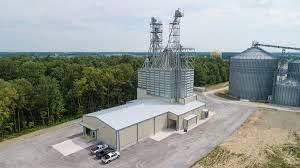 Prices for corn and soybeans were up by 2.6 and 1.9 percent respectively and soybean meal was higher by 0.9 percent compared to last week. Prices were influenced by technical selling arising from geopolitical concerns and revised projections for crop sizes in Brazil and Argentine. Secondary factors included disruption in shipping in the Red Sea and Panama Canal, carryover from the 2023 U.S. crop, export orders and the predicted ending stocks of corn and soybeans for the 2024 crop. There was no apparent response to release of the April WASDE that retained projections for production and ending stocks from the March report and release of the Planting Intentions Report. Prices for corn and soybeans were up by 2.6 and 1.9 percent respectively and soybean meal was higher by 0.9 percent compared to last week. Prices were influenced by technical selling arising from geopolitical concerns and revised projections for crop sizes in Brazil and Argentine. Secondary factors included disruption in shipping in the Red Sea and Panama Canal, carryover from the 2023 U.S. crop, export orders and the predicted ending stocks of corn and soybeans for the 2024 crop. There was no apparent response to release of the April WASDE that retained projections for production and ending stocks from the March report and release of the Planting Intentions Report.
At noon EDT on April 25th the CME price for corn was up 2.6 percent compared to the previous week to 438 cents per bushel for May delivery. Corn price was influenced by ethanol demand and the proportionally high ending stock of corn from the 2023 crop. Export orders for the current market year have increased in response to lower prices. Volumes and prices are indirectly influenced by higher wheat prices, events in the Black and Red Seas. Orders by China resumed at the end of the 2022-2023 market-year and have extended through March despite a slightly higher Dollar Index offset by a low FOB prices although with increased ocean freight. Total exports for the current market year are 33.5 percent higher than for the corresponding week during the 2022-2023 year.
Soybeans traded at 1,155 cents per bushel for May 2024 delivery, up 1.9 percent over the week. Lower prices were attributed to short covering, farm selling and availability from the 2024 Brazil and Argentine harvests. Total exports for the current market year are 18.1 percent lower than for the corresponding week in the 2022-2023 year.
Soybean meal traded at $341 per ton for May delivery, up 0.9 percent compared to $338 per ton for last week. Price was influenced by demand coupled with high crush volumes for consecutive months from December 2023 onwards with increased capacity. Price will fluctuate to reflect the CME price for soybeans and the demand for biodiesel despite the adverse financial situation in this sector. The market previously responded to the increased 2023 crop and higher stocks together with projections for 2024 unchanged from March in the April WASDE Report.
WTI was $4.91 (-5.6 percent) lower from last week to $82.33 on April 24th with moderate world demand in relation to supply. Price is lower partly due to a lull in the attacks on shipping in the Red Sea, and cessation of hostilities between Israel and Iran. It is accepted that U.S. production is a moderating influence, attaining 12.9 million barrels per day in March with ample reserves. An upward trajectory in price may occur if production cuts by OPEC amounting to 2 million barrels per day and extended through June actually materialize. There was a downward move in price during the week ($85.05 to $81.09 range). Crude oil inventory in the U.S., other than the Strategic Reserve, was down 2.0 percent to 32.4 million barrels last week. High U.S. production is constraining domestic and international prices but the rise in energy cost during past weeks is reflected in inflation restraining the FOMC from lowering the benchmark interest rate.
Economic data released on April 25th (Q1 GDP; PCE, Employment) confirmed slower growth and persistent inflation. A data-driven Federal Reserve FOMC will be disinclined to reduce the benchmark interest rate until the fall at the earliest.
Factors influencing commodity prices in either direction over the past four weeks included:-
- Weather conditions in areas of the World growing corn and oilseeds especially in Brazil and also Argentine with favorable rain recently under the influence of a strong El Nino The 2023 U.S. harvest was completed ahead of the corresponding weeks in 2022 with higher carryover and lower exports of soybeans. (Downward pressure on prices). Planting has commenced for the “new” crop of 2024.
- Geopolitical considerations continue to move markets, especially in the Mideast. Ongoing attacks on Ukraine port facilities have impacted prices of wheat, corn, oilseeds and vegetable oils. Loaded bulk vessels are sailing from Black Sea and Danube River ports using the ‘Humanitarian Corridor” to various destinations. This route is operational despite threats by the Russian Federation to mine the entrance to ports and deployment of airborne missiles. Exports from Ukraine are approaching 1.5 million metric tons per week with a total of 26 million metric tons market year through February, down 11 percent from the equivalent period for 2022-2023 year. Grain production in Ukraine during the current year will be lower than 2022/2023 (Downward pressure on corn and wheat and an indirect effect on soybeans)
- Macroeconomic U.S. factors:-
- Most economists in academia and the private sector are still confident of a “soft landing” for the economy despite the release of the Q1 2024 GDP and recent economic parameters including the CPI and PPI and with fluctuation in bond rates. Annual inflation as measured by CPI declined from 8.9 percent in June 2022 to 3.5 percent in March 2024. This is in part a response to a series of 11 FOMC rate raises that curbed inflation and cooled the labor market but without precipitating unemployment. There is evident stability in the bank sectors in both the U.S. and Europe. Large U.S. banks passed stringent mid-year “stress tests”. There is now concern over regional banks with exposure to commercial real estate. A rise in energy prices is contributing to persistence of inflation.
- The Federal Reserve held the benchmark interest rate steady at the monthly FOMC meeting on March 20th 2024, the fifth sequential pause. The Federal Reserve commentary indicated that the rate would be held at 5.25 percent until a pivot with possibly less than two reductions of 25 basis points each in 2024, after the September meeting at the earliest. Chairman Powell in Congressional testimony and documented in FOMC minutes has indicated that decisions would be based on data and demonstrable progress in reducing inflation towards an annual 2.0 percent target by mid-2025. Market optimism with projections of five reductions during 2024 was evidently premature.
- The March 28th Bureau of Economic Affairs released the advanced estimate of Q1 2024 GDP at 1.6 percent, below the consensus estimate of 2.4 percent. The Q1 GDP value was influenced by spending by both consumer and government-sectors and with higher investment in housing. By comparison Q4 2023 GDP growth was 3.4 percent. Growth in GDP attained 2.5 percent in 2023 up from 1.9 percent in 2022. The Q1 Personal Consumption and Expenditure Index For Q1 (excluding food and energy) was up 3.7 percent annualized, higher than 2.0 percent in Q4 2023.
- On March 29th the Bureau of Economic Analysis released the February Personal Consumption and Expenditure Price Index (excluding food and energy) that was up 0.3 percent from the previous month to 2.8 percent year-over-year. This was in line with estimates. Food prices increased 0.1 percent but energy was up 2.3 percent in March. The Headline PCE Index was up 2.5 percent year-over-year also corresponding to estimates. The price of goods increased 0.1 percent from February and was higher than services at 0.3 percent. Consumer spending was up 0.8 percent, above estimates and compared with 0.2 percent in January, impacted by weather. The headline PCE is closely followed by the Federal Reserve and confirms declining inflation.
- The April 10th Bureau of Labor Statistics release of the March 2024 CPI confirmed a 0.4 percent increase from February, and 0.1 percent above forecast. The annual increase of 3.5 percent was up from 3.2 percent in February and higher than the anticipated value. The increase in the core value (excluding food and energy) was 0.4 percent from February and 3.8 percent for the 12-month period, and estimates. Food at home was unchanged from the previous month. The category of ‘meat, fish and poultry’ was up collectively by 0.9 percent with eggs up 4.6 percent from the previous month. Food away from home was up 0.3 percent from February. On an annual basis all food was up 2.2 percent with food at home up 1.2 percent and food away from home up 4.2 percent. Energy was up 1.1 percent together with natural gas (-3.2 percent) in March. The shelter category was up 0.4 percent for the month and 5.7 percent over the past year. The macro trend is inclining towards reduced inflation due to a fall in energy prices but this category has recently moved up, detracting from deflation. The CPI heavily influences FOMC rate decisions.
- The March Producer Price Index for Final Demand (PPI) released on April 11th was up by 0.2 percent from February compared to an expectation of 0.3 percent. The PPI was up 2.1 percent over the past 12-months. This is compared to a 6.4 percent increase in 2022. The core PPI value excluding volatile fuel and food, was up 0.2 percent for March and up 2.8 percent for the 12-month period. Food was up 0.8 percent compared to a 1.1 percent increase in February.
- A Federal Reserve release on April 16th confirmed that industrial production rose 0.4 percent in March. Capacity utilization was fractionally higher at 78.4 percent, 1.2 percent below the 1972-2020 average.
- The April 24th report on Durable Goods Ordered during March 2024 was higher by 2.6 percent to $283 Billion compared to a revised value of 0.7 percent or $376 Billion in February. Transportation and specifically aircraft orders were up 7.7 percent. Excluding the Transportation component, new orders increased by 0.2 percent in March compared to February. Shipments of durable goods were essentially unchanged from February that in turn was up 1.2 percent from January 2024 impacted by severe weather.
- The April 15th release of retail sales data showed a monthly rise of 0.7 percent in March. This value is compared to the revised 0.9 percent rise in February 2024, reflecting a rebound from depressed sales in January affected by harsh winter storms and a change in the basis of calculation. Retail sales in March 2024 were up 4.0 percent from the corresponding month in 2023. The Federal Reserve FOMC closely monitors retail sales as a measure of the trend in inflation.
- The April 1st release by the Institute for Supply Management (ISM®) documented the Manufacturing Index for March at 50.3 up from 47.8 in February and above the consensus of 48.4. New orders increased to 51.6 (49.2, February) and Production attained 54.6 (48.4, February).
- The April 23rd release of the S&P Global Composite U.S. Manufacturing PMI for April fell to 50.9 compared to revised 52.1 in March. The Global Services PMI fell from 51.7 in March to 51.7 in April.
- The Conference Board Consumer Confidence Index released on March 26th for February/March, rose to 104.7 points. This reading was almost unchanged from a revised 104.8 for the preceding four-week period. The Present Situation Index was up to 157.0 in March from 147.6 in February. The Expectations Index fell to 73.8 in March from 76.3 in February with values below 80.0 suggesting a future recession
- The April 13th University of Michigan Preliminary Index of Consumer Sentiment fell 1.5 points to 77.9 for April down from a revised final value of 79.4 in March. The Index was up from 63.7 in April 2023. Both the Current Economic Index (79.3 down from 82.5 but not statistically significant) and the Index of Consumer Expectations (74.7 down from 77.4 in March) denote a decline in consumer sentiment influenced by stable but high interest rates and inflation despite geopolitical concerns. Inflation expectations 12-months hence moved higher from 2.9 to 3.1 percent among those surveyed.
- Non-farm payrolls added 303,000 for March, as documented by the Bureau of Labor Statistics on April 5th. This was more than the anticipated 214,000, and compares to the revised February value of 270,000. The increase is attributed to workers in the health care and government sectors. The unemployment rate fell to 3.8 percent with 15 million unemployed. Real average weekly earnings for March showed a 0.3 percent increase over February. Average hours worked rose 0.1 percent to 34.4 per week in March. Labor participation increased fractionally from 62.5 percent in February to 62.7 percent in March. Wage rates increased 4.1 percent over 12-months, the lowest gain since June 2021. Wage rates are closely followed by the Federal Reserve FOMC.
- The Bureau of Labor Statistics Job Openings and Labor Survey report released on April 2nd estimated 8.8 million job openings at the end of February, down 100,000 (-0.1 percent) from January 2024 and consistent with estimates. The February job openings number was the lowest value in 34 months and compares with the March 2022 value of 12.2 million during COVID.
- The seasonally adjusted initial jobless claims figure of 207,000 released on April 25th was 5,000 lower than the revised seasonally adjusted value for the week ending April 20th but lower than the Reuter’s estimate of 215,000. The four-week moving average declined to 213,250 The Bureau of Labor Statistics estimated 1.78 million continuing claims for the week ending April 13th down 15,000 from the previous week. There is evidence from data over the past three months that the labor market is cooling despite sporadic weekly fluctuation in new claims.
- The April 5th Bureau of Labor Statistics report recorded a 0.7 percent increase in non-Farm Productivity for 2023. Output increased by 2.6 percent with a 1.9 percent increase in inputs of labor and capital. Hours Worked was up by 1.3 percent in 2023
- The ADP® reported on April 3rd that private payrolls increased by 184,000 in March, up 29,000 from the revised 155,000 in January and compared to the Bloomberg estimate of 150,000 jobs. The increase in employment was mostly in the construction, financial services and manufacturing sectors. Annual pay was up 5.1 percent year-over-year unchanged from February. The increase will not directly influence the probability of short-term future changes in interest rate since the ADP® is regarded by the FOMC as an unreliable statistic
FACTORS INFLUENCING COMMODITY PRICES
- The 2023 harvests of corn and soybeans were completed by late November 2023. The April 11th WASDE projected acreage to be planted, yields, crop size and ending stocks for the 2024 crop.
- It is evident that both polarization in the closely divided chambers of Congress and intra-party conflict between and within both sides of the aisle in the House delayed adoption of appropriations bills. Passage of the 2023 Farm Bill will be contentious and is subject to a 12-month extension as a stop-gap measure. Progress on the 2023 Farm Bill has been impeded by contention over SNAP eligibility and other entitlements that collectively represent 75 percent of total expenditure. The August 2nd downgrade of U.S. debt from AAA to AA+ by Fitch Ratings recognizes Congressional dysfunction. On November 10th 2023 Moody’s downgraded U.S. credibility from ‘stable’ to ‘negative’ based on an inability to pass required fiscal legislation. After four Continuing Resolutions the House and Senate passed six appropriations bills including the FDA and USDA, avoiding a March 8th partial shutdown of the Federal Government. Agreement was concluded on the remaining appropriations bills on March 23rd maintaining Federal funding through October 2024. Currently the Speaker of the House is experiencing difficulty in passing legislation.
- The delayed 2023 Farm Bill is mired in conflict in both the House and Senate. There is no consensus on major issues comprising the magnitude of SNAP payments and eligibility and requested price supports for crops. The Chair of the Senate Agriculture Committee Sen. Debbie Stabenow (D-MI) is standing firm on maintaining both SNAP-WIC benefits and climate remediation funding even if the Farm Bill is delayed through to the 119th Congress
- The April 11th WASDE #647 Projected both corn and soybean production parameters with a potential record corn harvest for the 2024 crop. There will be ample world availability of ingredients although inequitable distribution will result in shortages in some nations. Soybean exports will comprise 38.2 percent of the 2024 U.S. crop with a 7.7 percent increase in ending stock to 340 million bushels as compared to the March WASDE Report.
- Rabobank projected the soybean crop in Brazil at 153 million metric tons on April 4th. This value is higher than the projection by CONAB (the Soy production association in Brazil) at the midpoint of the soybean harvest, of 147 million metric tons (5,401 million bushels) down from a previous estimate of 155 million metric tons (5,695 million bushels). Exports of 100 million metric tons (3,674 million bushels). It is anticipated that Brazil will crush 56 million metric tons (2,057 million bushels). If CONAB is correct the harvest will be 7 million metric tons (269 million bushels) lower than the 2023 record crop. Brazil exported 7.0 million metric tons (257 million bushels) of soybeans to China over the first two months of 2024, double the quantity shipped to this nation over the corresponding two months in 2023.
- Corn production in Brazil for the 2023-2024 market year will attain 124 million metric tons (4,801 million bushels) from all three sequential harvests. But down seven percent from the previous year. Brazil is projected to export of 54 million metric tons (2,125 million bushels). Argentine will produce 50 million metric tons of corn (1,968 million bushels), double compared to the previous year impacted by drought. (Lower prices in the future subject to favorable reports on crop progress and actual harvests)
- The Dollar Index (DXY) was 105.8 at close on April 24th, down 0.1 point from last week responding to CPI data suggesting retention of current benchmark interest rates for a prolonged period. The DXY has ranged from 99.0 to 107.0 over the past 52 weeks. The dollar index influences timing and volume of export orders and indirectly the price of WTI crude.
 
|
Sanovo Introduces GraderPro 800
|
04/25/2024 |
|
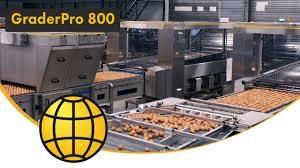 Sanovo Technology Group has introduced the GraderPro 800 with a capacity of 288,000 eggs per hour corresponding to 800 cases. To accommodate this volume the system incorporates two infeed lines. The tunnel operates with eight tracks allowing the GraderPro 800 to operate at a track speed approximately 25 percent lower than competitors’ graders. Sanovo Technology Group has introduced the GraderPro 800 with a capacity of 288,000 eggs per hour corresponding to 800 cases. To accommodate this volume the system incorporates two infeed lines. The tunnel operates with eight tracks allowing the GraderPro 800 to operate at a track speed approximately 25 percent lower than competitors’ graders.
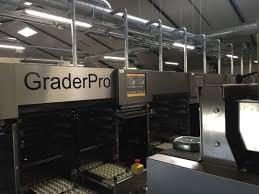
The GraderPro installation features cleaning in place, recycling of ‘grey’ water and cleaning of modules without disassembly. All machine parts incorporate approved food-contact material. Operation and monitoring is based on an advanced touchscreen console.
Modules compatible with the GraderPro 800 include the Sanovo OptiAccumulator with a compatible OptiLoader, UV disinfection, VisionAI grading, Blood Detector and Inkjet Printing to conform to EU requirements. Configuration of the installation allows for a small footprint relative to volume permitting retrofitting in existing plants and reducing the required floor area for new buildings.
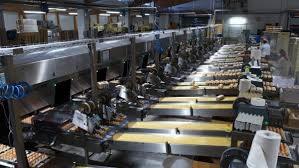
The GraderPro 800 incorporates egg tracking to farm or flock of origin for comprehensive traceability.

|
Additional Kroger-Albertson Divestiture Plan Rejected by FTC
|
04/24/2024 |
|
 In an attempt to appease the Federal Trade Commission (FTC), The Kroger Company and Albertsons Companies announced that 166 additional stores will be added to the list that will be divested to C&S Wholesale Grocers for a total of 579 locations. In an attempt to appease the Federal Trade Commission (FTC), The Kroger Company and Albertsons Companies announced that 166 additional stores will be added to the list that will be divested to C&S Wholesale Grocers for a total of 579 locations.
According to a Kroger press release, C&S will operate the Safeway banner in Arizona and Colorado and will license the Albertsons banner in California and Wyoming. Presumably this will be convenient for Kroger and Albertsons should the anticipated transaction be concluded and subsequently C&S goes the way of Haggen after the Safeway transaction in 2016.
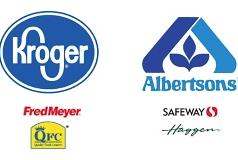 The merger elicited a negative response from the FTC. The Agency stated, “The proposal completely ignores many affected regional and local markets where Kroger and Albertsons compete today.” The statement added, “In areas where there are divestitures, the proposal fails to include all of the access, resources and capabilities C&S will need to replicate the competitive intensity that exists today between Kroger and Albertsons. Even if C&S were to survive as an operation, Kroger and Albertsons proposed divestitures still do not solve the multitude of competitive issues created by the proposed acquisition.” The merger elicited a negative response from the FTC. The Agency stated, “The proposal completely ignores many affected regional and local markets where Kroger and Albertsons compete today.” The statement added, “In areas where there are divestitures, the proposal fails to include all of the access, resources and capabilities C&S will need to replicate the competitive intensity that exists today between Kroger and Albertsons. Even if C&S were to survive as an operation, Kroger and Albertsons proposed divestitures still do not solve the multitude of competitive issues created by the proposed acquisition.”
In support of the proposed merger/acquisition, the CEO of The Kroger Company, Rodney McMullen stated, “Our proposed merger with Albertsons will bring lower prices and more choices to more customers and secure the long-term future of unionized grocery jobs.” McMullen noted that the divestiture plan would ensure that no stores will close, and all frontline associates will remain employed with continuation of existing collective bargaining agreements. The Kroger Company intends to support C&S operations “through expanded transition services.”

|
WOAH Concerned over HPAI Impact on Wildlife
|
04/24/2024 |
|
 In a mid-March statement, the World Organization of Animal Health (WOAH) warned of the threat to wildlife from highly pathogenic avian influenza. The statement was prompted by a diagnosis of H5N1 HPAI in skuas collected by scientists at the Primavera Antarctic Research Base operated by Argentine. The WOAH statement included, “Once considered primarily a threat to poultry, HPAI has ushered in a new normal whereby HPAI is moving from wild birds to wild mammals with impacts beyond anything previously seen.” The statement continued, “At the latest count there have been 485 species from over 25 avian orders affected and 37 new mammal species infected since 2021. Only the Pacific Islands, Australia and New Zealand remain free of the disease, but the situation is changing rapidly.” In a mid-March statement, the World Organization of Animal Health (WOAH) warned of the threat to wildlife from highly pathogenic avian influenza. The statement was prompted by a diagnosis of H5N1 HPAI in skuas collected by scientists at the Primavera Antarctic Research Base operated by Argentine. The WOAH statement included, “Once considered primarily a threat to poultry, HPAI has ushered in a new normal whereby HPAI is moving from wild birds to wild mammals with impacts beyond anything previously seen.” The statement continued, “At the latest count there have been 485 species from over 25 avian orders affected and 37 new mammal species infected since 2021. Only the Pacific Islands, Australia and New Zealand remain free of the disease, but the situation is changing rapidly.”
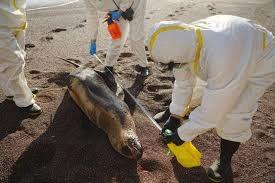
The WOAH Working Group on Wildlife has produced guidelines on vaccination of species under conservation. California Condors have been vaccinated under special license in the U.S. following mortality presumably from scavenging dead waterfowl.
The WOAH notes that the magnitude of losses “at the current scale presents an unprecedented risk of wildlife population collapse creating an ecological crisis.”
The WOAH emphasizes the need for interagency coordination and collection of data through the World Animal Health Information System.
EGG-NEWS has reported on outbreaks involving high mortality in numerous wild avian species including cranes in Israel and India, swans in the E.U., Dalmatian pelicans and endangered barnacle geese. (retrievable by entering “avian influenza” in the SEARCH block). The recovery of H5N1 HPAI virus from free-living birds including grackles and blackbirds associated with bovine influenza-H5N1 suggests that the infection is now endemic in the U.S. and is not confined to migratory waterfowl.

|
Egg Week
|
04/24/2024 |
|
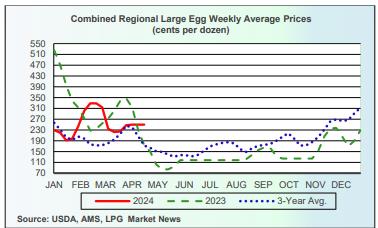 USDA Weekly Egg Price and Inventory Report, April 24th 2024. USDA Weekly Egg Price and Inventory Report, April 24th 2024.
Market Overview
- The average wholesale unit revenue values for Midwest Extra-large, Large and Medium sizes were unchanged this past week. Wholesale price for Midwest in cartons at $2.50 per dozen was approximately $0.90 per dozen above the 3-year average of $1.60 per dozen and up $0.80 from the corresponding week in 2023 at $1.70 per dozen. This past week shell egg inventory was up by 1.5 percent, reversing a fall of 1.4 percent the previous week.
- Although there has been a weekly increase in pullet flocks transferred to laying houses, hen numbers are constrained by the loss of close to 13 million hens due to HPAI on twelve complexes holding from 250,000 to 2.6 million hens during the 4th Quarter of 2023. Pullets are in short supply with losses of 2.5 million growing birds, mainly in California. Since the beginning of April close to 8.4 million hens collectively have been depopulated in a sequence comprising one complex in Texas and three related facilities under common ownership in Michigan in addition to a breeder complex in New Mexico.
- This past week chains apparently narrowed the spread between delivered cost and shelf price. This could result in a continued reduction in generic stock with a proportional rise in demand but only with constant re-ordering to fill the pipeline into May. Discounters are holding prices on generics influencing mainstream retail stores. Eggs are still highly competitive in price against the comparable costs for other protein foods.
- Total industry inventory was up by 1.3 percent overall this past week to 1.64 million cases with a concurrent 0.2 percent increase in breaking stock, following a 1.9 percent increase during the preceding processing week. Demand for egg products continues into May despite less home baking and entertaining. Egg products are required for the food service and manufacturing sectors and for exports that increased in February.
- It is now apparent that the inventory held by chains and other significant distributors may be more important over the short term in establishing wholesale price compared to the USDA regional inventory figures. Changes in stock held by DCs and in the pipeline as determined by weekly orders are probably responsible for small cyclic fluctuation in weekly industry stock, especially into and after a holiday weekend.
- Cases of HPAI in the commercial poultry industry and backyard (non-commercial WOAH) flocks tapered during the first quarter of 2024, coincident with the end of the Fall migration of waterfowl that was extended in late 2023 by mild weather. The emergence of the infection in a large complex with 2 million birds in western Texas suggested a reoccurrence of the epornitic as northward spring migration has commenced. The three subsequent related cases in Michigan involving a total of 6.4 million hens may have commenced as an indirect extension from an infected dairy herd although an epidemiologic evaluation in progress will be required to confirm the source and routes of intra-Company dissemination. The number and extent of future possible outbreaks during the spring and fall months of 2024 cannot be projected but sporadic cases in backyard poultry and 32 dairy herds in eight widely diverse states is a cause for concern. More surveillance information should be released by USDA-APHIS as it becomes available concerning the prevalence rate of carriers among resident domestic free-living birds and a review of molecular and field epidemiology for the 2022 spring and fall waves of HPAI. The USDA has yet to identify and release specific modes of transmission for the 2022-2023 epornitic including likely airborne spread from wild birds and their excreta over short distances.
- The current relationship between producers and chain buyers based on a single commercial price discovery system constitutes an impediment to a free market. The benchmark price appears to amplify both downward and upward swings as evidenced over the past two years. A CME quotation based on Midwest Large, reflecting demand relative to supply would be more equitable. If feed cost is determined by CME ingredient prices then generic shell eggs should be subject to a Midwest Large quotation.
- According to the USDA the U.S. flock in production was apparently up by 0.9 million hens (0.3 percent) to a new level of 307.0 million for the week ending April 24th The stated total flock of 312.3 million included about one million molted hens that will resume lay during coming weeks plus 4.5 million pullets scheduled to attain production. Given the latest figures it is estimated that the producing flock is at least 17 to 20 million hens lower than before the onset of HPAI in 2022. In January 2024 the USDA adjusted figures to account for depopulation of 13 million hens spread over the last quarter of 2023. There were evident discrepancies between published figures and the theoretical number of hens over successive weeks taking into account known losses and predetermined pullet replacements. The April loss of 8.4 million hens is not reflected in data released over the past three weeks. It is hoped that the USDA Agency responsible for publication of flock size will get their act together and coordinate with APHIS to record the number of depleted flocks and promptly provide accurate data. Figures released on April 24th have overestimated flock size
- The ex-farm price for breaking stock (rounded to one cent) was unchanged at $1.58 per dozen.Checks delivered to Midwest plants were up 0.7 percent to $1.43 per dozen this past week. Prices for breaking stock should follow the wholesale price for shell eggs usually with a lag of about one to two weeks.
The Week in Review
Prices
According to the USDA Egg Market News Reports released on April 22nd 2024, the Midwest wholesale price (rounded to one cent) for Extra-large was unchanged from last week at $2.43 per dozen. Large was unchanged at $2.41 cents per dozen. Mediums were unchanged at $2.30 per dozen delivered to DCs. Prices should be compared to the USDA benchmark average 4-Region blended nest-run cost of 75.3 cents per dozen as determined by the Egg Industry Center based on USDA data for March 2024. This value excludes provisions for packing, packaging materials and transport, amounting to 57 cents per dozen as determined in mid-2023 from an EIC survey (with low response) and now realistically 60 cents per dozen.
Currently producers of generic shell eggs should be operating with positive margins irrespective of region and customer-supply agreements. The progression of prices during 2023 and 2024 to date is depicted in the USDA chart reflecting three years of data, updated weekly.
 
|
France Implementing Vaccination Program
|
04/24/2024 |
|

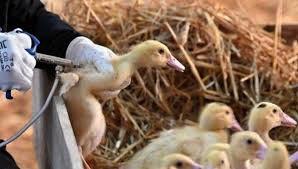
|
Following successive years of severe losses as a result of exposure to HPAI, France initiated a preventive vaccination program in ducks and geese reared for the foie gras segment of their poultry industry. To date 26 million waterfowl have received the initial dose of vaccine with 21 million receiving a second booster dose.
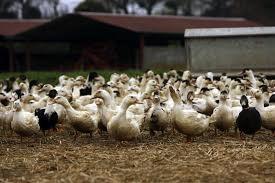
During the 2022-2023 epornitic of HPAI, 315 farm outbreaks were recorded with 22 million commercial birds depopulated. Since the autumn of 2023, ten cases have been diagnosed.
The success of the vaccination program will be confirmed by an analysis of data relating to outbreaks following a complete season with direct comparisons between vaccinated and non-vaccinated susceptible flocks.
|

|
Crimson Holdings LLC files for Chapter 11 Protection
|
04/24/2024 |
|

On April 8th, Crimson Holdings LLC an egg breaking enterprise located in Adrian Wisconsin filed for Chapter 11 protection.

The facility was the production unit of OvaInnovations Inc. and was converted to processing inedible product from a milk drying plant. From the inception of operation, the plant was associated with resident complaints over odor, investigated by the state environmental agency. The operation was embroiled in legal action including a dispute with IsoNova Technologies LLC.

David Rettig was the moving force behind OvaInnovations Inc. Rettig was instrumental in establishing Rembrandt Enterprises in 1999 with financing provided by entrepreneur Glenn Taylor of Minneapolis. In 2009 Rembrandt acquired Golden Oval eggs. Rembrandt was impacted by two episodes of highly pathogenic avian influenza. The production facility in Rembrandt, Iowa is now owned and operated by AGR Partners.

|
Farmerboy Barntalk
|
04/24/2024 |

|
Target Lawsuit over Biometrics Surveillance
|
04/24/2024 |
|
 The Biometric Information Privacy Act enacted in 2008 in the state of Illinois provided protection to customers from undisclosed collection and use of biometric data. The Biometric Information Privacy Act enacted in 2008 in the state of Illinois provided protection to customers from undisclosed collection and use of biometric data.
Target along with numerous retailers is plagued with theft and has introduced systems to identify serial shoplifters. The Illinois Act makes it unlawful for a company to “collect, capture, purchase, receive or otherwise obtain a person’s biometric identifiers without informed consent and approval in writing.”
The application of biometric surveillance is highly contentious. Rite Aid agreed to cease using facial recognition technology following action by the Federal Trade Commission. Defects in the technology used incorrectly identified innocent shoppers as potential serial shoplifters.
Facial recognition technology has many drawbacks including differentiation among people of color. Identifying individuals in large groups is practiced by the Government of the People’s Republic of China to identify political dissidents and potential provocateurs in street gatherings.

|
Sale of Grubhub Contemplated
|
04/24/2024 |
|
 Parent company Just Eat based in the Netherlands is actively seeking a buyer for their Grubhub operation in the U.S. Parent company Just Eat based in the Netherlands is actively seeking a buyer for their Grubhub operation in the U.S.

Just Eat processed 214 million orders in all their operations during the first quarter of FY 2024, down six percent from the corresponding quarter of FY 2013. Transaction value was down 1.8 percent to $7.0 billion for the most recent quarter.

|
Crop Progress
|
04/23/2024 |
|
Status of the 2024 Corn and Soybean Crops
The USDA Crop Progress Report released on April 22nd documented planting for the 2024 soybean and corn season. Farmers are in fields with relatively dry conditions in half of the eight major states producing corn and soybeans allowing rapid seeding of prepared acreage. The “big-eight” (IL, IN, IA, KS, MI, MN, NE and OH) collectively averaged 3.5 days suitable for field work this past week ranging from 2.0 days (OH) to 5.9 days (KS)
Based on the sum of the “adequate” and “surplus” categories, surface and subsoil moisture levels were higher than the corresponding week in 2023. For the past week surface and subsoil moisture values were both 72 percent for the two highest categories of ‘Adequate’ and ‘Surplus’. These levels were higher than the previous year with values of 67 percent for the two highest categories, demonstrating an acceptable pre-planting situation. It is to early in the expected transition to a La Nina event to predict any impact on crop condition in coming weeks. If dry and hot weather in corn and soy areas occurs yield may be depressed depending on timing and severity.
Reference is made to the April 11th WASDE Report #647 under the STATISTICS TAB and the weekly Commodity, Economy and Energy Report in this edition, documenting acreage to be harvested, yields, weekly prices and ending stocks.
| |
WEEK ENDING |
|
|
Crop (18 states)
|
March 31st 2024
|
April 7th 2024
|
5-Year Average
|
|
Corn Planted (%)
Corn Emerged (%)
|
6
0
|
12
3
|
10
2
|
|
Soybean planted (%)
|
3
|
8
|
4
|
| |
|
|
|
|

|
|
|
Crop Condition
(pending USDA reports)
|
V. Poor |
Poor
|
Fair
|
Good |
Excellent |
|
Corn 2024 (%)
Corn 2023 (%)
|
|
|
|
|
|
|
Soybeans 2024 (%)
Soybeans 2023 (%)
|
|
|
|
|
|
| |
|
|
|
|
|
|
|
|
|
Parameter 48 States
|
V. Short |
Short
|
Adequate
|
Surplus |
| Topsoil Moisture: |
|
|
|
|
|
Past Week
Past Year
|
7
11
|
21
17
|
61
59
|
11
13
|
| Subsoil Moisture: |
|
|
|
|
|
Past Week
Past Year
|
9
13
|
24
21
|
58
56
|
9
10
|
| |
|
|
|
|
|
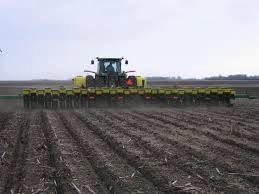 |
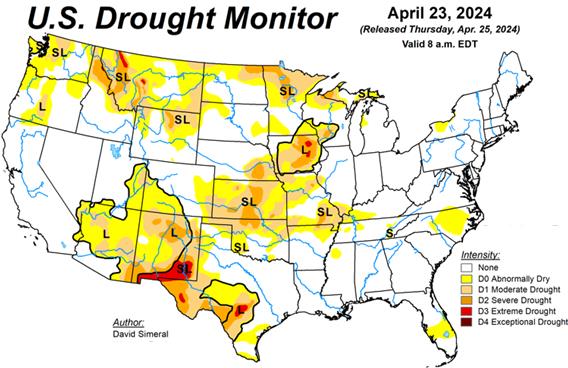 |
EGG-NEWS will report on the progress of the two major crops as monitored by the USDA through to the end of the 2024 harvest in November.

|
Albertson’s Posts 4th Quarter and FY 2023 Financial Results
|
04/23/2024 |
|
 In an April 22nd 2024 release, Albertson’s Companies (ACI) posted financial results for the 4th quarter and fiscal 2023 ending February 24th 2024. Earnings were consistent with expectations but sales were lower than consensus estimates. As the second largest pure-grocery company, Albertson’s can be regarded as a bellwether for the retail food industry, subject to increased costs of foods, labor, and transport in a competitive consumer environment impacted by inflation as reflected in low net margins among competitors. In an April 22nd 2024 release, Albertson’s Companies (ACI) posted financial results for the 4th quarter and fiscal 2023 ending February 24th 2024. Earnings were consistent with expectations but sales were lower than consensus estimates. As the second largest pure-grocery company, Albertson’s can be regarded as a bellwether for the retail food industry, subject to increased costs of foods, labor, and transport in a competitive consumer environment impacted by inflation as reflected in low net margins among competitors.
Albertsons operates 2,270 stores under 21 banners including Albertson’s, Safeway, Von’s, Acme, Jewel-Osco and Shaw’s. Albertson’s Companies posted a 1.0 percent increase in same-store sales during the most recent quarter with a 24 percent increase in digital sales over the corresponding Q4 of FY 2022. Loyalty membership increased 16 percent to 39.8 million.
For Q4 net income was $280.5 million on total revenue of $18,340 million. Comparable figures for the fourth quarter of fiscal 2022 ending February 25th 2023 were net income of $311.1 million on total revenue of $18,265 million. Diluted EPS for Class A shares for the most recent quarter was $0.43 down from $0.54 for Q4 FY 2022. Gross margin increased fractionally from 27.8 percent to 28.0 percent denoting minor reduction in cost of goods sold reflecting deflation. Operating income decreased from 2.4 percent in Q4 FY 2022 to 2.3 percent. During Q4 FY 2022 Albertsons recorded a $61.4 million gain on property disposition and $9.5 million assigned to the ‘other income’ category.
For FY 2023 net income was $1,296 million on total revenue of $79,238 million with a diluted EPS of $2.23. Comparable figures for fiscal 2022 ending February 26th 2023 were net income of $1,514 million on total revenue of $77,650 million with a diluted EPS of $2.27
In commenting on results CEO Vivek Sankaran stated, “We delivered another solid quarter amidst a difficult industry backdrop. Again during this quarter, we focused on our strategy to create Customers for Life, which drove strong growth in digital and pharmacy, deepened our omnichannel relationships with our customers and improved our in-store experience”.

Sankaran concluded, "We expect to face ongoing headwinds posed by investments in associate wages and benefits, cycling significant prior year food inflation, lower government assistance for our customers, declining COVID-related income, and the increasing mix of our pharmacy and digital businesses, which carry lower margins. We expect these headwinds to be much stronger in the first half of fiscal 2024. These headwinds are expected, to be partially offset by ongoing productivity initiatives."
On Friday October 14th 2022 Kroger announced a bid for Albertson’s offering $34 per share and assuming $4.7 billion in debt in a $25 billion transaction. The acquisition would at the least have required divestment of stores among in areas with an overlap. Several U.S. senators, states Attorneys General and unions representing Albertson’s workers oppose the transaction. The parties to the merger offered to spin off 413 stores and eight DCs to C&S Wholesalers, since increased by an additional 166 stores. The combined company would invest in worker benefits, devote $1 billion of working capital to reduce prices and would recognize unions.
On January 15th in advance of a Federal Trade Commission decision, the parties issued a joint statement “We remain in active and ongoing dialogue with the FTC and individual state Attorneys General regarding our proposed merger and divestiture plan. We believe our merger with Albertsons and the comprehensive divestiture to C&S will result in the best outcomes for customers, associates and our communities”.
The FTC sued to block the merger in mid-February 2024 supported by eight states and Washington DC. with a hearing to commence on August 12th 2024.
Albertson’s Corporation posted assets of $26,221 million including $3,636 million in goodwill and intangibles, against long-term debt and lease obligations of $15,207 million. The Company had an intraday market capitalization of $11,630 million on April 23rd 2014. ACI trades with a forward P/E of 7.8 and has ranged over a 52-week period from $19.88 to $23.88 with a 50-day moving average of $20.89. Approximately 74 percent of equity is held by institutions with 14 percent by insiders. The Company attained a 12-month trailing operating margin of 2.7 percent and a profit margin of 1.6 percent. Return on assets was 5.6 percent and 58.9 percent on equity.

|
Fur Farms in China Represent a Potential for the Emergence of Pandemics
|
04/21/2024 |
|
A review of fur farms in Hebei and Liaoning Provinces revealed risks for the emergence of pandemic strains of zoonotic viruses according to Dr. Alastair MacMillan of Surrey University, U.K. Holding as many as 4,000 animals of diverse species including foxes, raccoon dogs and mink represented a potential for viruses to undergo mutation and recombinant events. The risk was intensified by proximity to farms housing high concentrations of commercial poultry.

During the early stages of the COVID pandemic in China, restrictions were placed on fur farms in addition to the breeding and consumption of exotic animals as food. It appears that restrictions have either been ignored or rescinded.
EGG-NEWS is opposed to fur farming in the U.S., the E.U., China or anywhere else based on the fact that commercial production may lead to emergence of zoonotic viruses. The end-product of fur farming has as its objective satisfaction of vanity and ostentatious display of wealth.
|
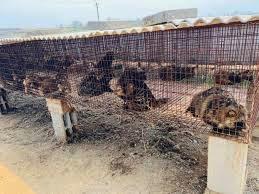

|

|
Concern in Latin America over El Nino Transition to a La Nina Event
|
04/21/2024 |
|
 Over many decades, the regular transition from El Nino to La Nina events with a neutral intermediate period has occurred over three-to-seven-year cycles. More recently, for conditions that are not fully understood, transitions are occurring over shorter periods and the intensity of drought associated with La Nina and floods and hurricanes concurrent with an El Nino are becoming more intense. Over many decades, the regular transition from El Nino to La Nina events with a neutral intermediate period has occurred over three-to-seven-year cycles. More recently, for conditions that are not fully understood, transitions are occurring over shorter periods and the intensity of drought associated with La Nina and floods and hurricanes concurrent with an El Nino are becoming more intense.
The International Research Center for the El Nino Phenomenon noted, “A year ago we came out of a La Nina and in March there were signs of a transition to El Nino. Rapid changes in the cycle will undoubtedly impact crop production with corresponding economic effects”.
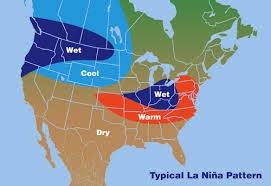
It is noted that the intense La Nina over the past three years was responsible for drought-reated low yields for crops in Chile and Peru. Reduced water flow through the Panama Canal, has restricted passage of vessels and has raised the cost of ocean transport. The ongoing El Nino was expected to restore water levels in the Canal but with an unexpected and abrupt return to a La Nina the unfavorable situation may persist.

|
California QSRs Raise Menu Prices Following FAST Act
|
04/21/2024 |
|
Following mandated wage increases in California, national QSR chains and casual dining restaurants have predictably raised menu prices, ostensibly to cover increased wage cost. In accordance with the FAST Act, the minimum wage for fast food chains was $20 per hour effective April 1st.

Studies have shown that menu prices started to rise in October 2023 disproportionately with the rest of the U.S. During March 2024, some fast food and fast casual restaurants increased menu prices by 16.5 percent. The average total increase in menu prices in California was 6.8 percent compared to the national average of 6.7 percent. Increases are regional according to market research company Datassential with higher prices in counties known to have high costs of living. Although the $20 per hour minimum is higher than the average state minimum wage, a shortage of workers resulted in increases in wage rates independently of the FAST Act. Menu increases are inevitable given that labor represents approximately one third of the cost of meals served.
|

 |

|
Egg Projection
|
04/19/2024 |
|
Updated April 2024 USDA Projection for U.S. Egg Production and Consumption.
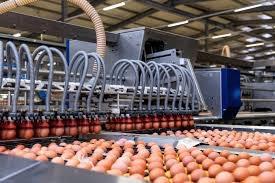 On April 17th 2024 the USDA Economic Research Service (ERS) issued confirmed values for egg production during 2022 with a projection for 2023 and a forecast for 2024. Production, consumption and prices were only slightly revised from the previous March 14th 2024 report. On April 17th 2024 the USDA Economic Research Service (ERS) issued confirmed values for egg production during 2022 with a projection for 2023 and a forecast for 2024. Production, consumption and prices were only slightly revised from the previous March 14th 2024 report.
Projected egg production for 2023 was unchanged from the March 2024 Report at 7,864 million dozen This will be 0.5 percent higher than in 2022 due to progressive replacement of the 44 million hens depleted due to HPAI over the period extending from early spring through mid-December 2022. The per capita consumption of shell eggs and liquids combined for 2023 was unchanged from the March report at 279.3 eggs but down 1.2 eggs (0.4 percent) from 2022. The projected average 2023 benchmark New York bulk unit price was unchanged from the March report at 192 cents per dozen. This was 31.8 percent lower than in 2022 attributed to a comparison with unseasonal high prices from the end of March through the 2nd Quarter of 2023.
Subsequent USDA projections will provide greater clarity on the recovery in consumption in an economy that is undergoing deflation. The 2023 Midwest in-carton national wholesale price peaked at $5.17 per dozen on January 3rd 2023 but fell precipitously to a market bottom of $0.78 per dozen on May 8th 2023. Price was restored during February 2024 and settled at $2.50 per dozen on April 12th 2024, higher than for the post-Easter period. This was above the USDA/EIC projection of the combined nest-run March 2024 cost of 75.3 cents per dozen for caged white Large, plus a provision for processing, packaging and transport of 60 cents per dozen amounting to $1.35 cents per dozen delivered to a distribution center.
Restoration in flock size after HPAI flock depletions in 2022 progressed at a rate of approximately 0.5 million per week but placements were limited by the availability of pullet chicks and in some companies the rate of conversion to alternative housing systems. Restoration of the national flock was compromised by a resurgence of HPAI with 13.0 million layers depleted during the 4th quarter of 2023 representing 4.0 percent of the nominal producing flock of 325 million hens, mainly on complexes averaging over one million hens. The cost of ingredients will influence margins and may result in cessation of production by some small-scale producers that run out of working capital since financial losses were incurred through summer up to mid-fall. Unpredictable factors affecting price will include the extent of losses during the spring of 2024 due to a predicted reemergence of avian influenza. Approximately 8.5 million hens have already been lost to HPAI during April to date involving mainly four large complexes. Exports of eggs and products at approximately two percent of total production will not materially affect the domestic price.
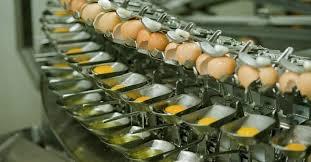 The lagging forecast for 2024 includes production of 7,920 million dozen, up 0.7 percent from 2023. Consumption will attain 280.6 per capita, up a more realistic 1.3 eggs or 0.5 percent above the projection for 2023. USDA project a NY-Large price of $2.03 per dozen up 5.7 percent from the average for 2023. The lagging forecast for 2024 includes production of 7,920 million dozen, up 0.7 percent from 2023. Consumption will attain 280.6 per capita, up a more realistic 1.3 eggs or 0.5 percent above the projection for 2023. USDA project a NY-Large price of $2.03 per dozen up 5.7 percent from the average for 2023.
In 2023 egg exports as shell and products combined attained 5,161 million dozen shell-equivalents, or 2.2 percent of production. During 2022 egg imports as a result of HPAI depopulation, some in shell form but predominantly products, attained 25.9 million dozen shell-equivalents, up 42.8 percent from 14.9 million dozen and 26.4 percent from 2021.
During 2023 shell egg exports attained 89.4 million dozen, up 28.6 percent compared to 2022 when high domestic prices prevailed. Egg products were up 18.2 percent to 20,814 metric tons compared to 2022. For the first two months of 2024 shell egg exports were up 8.9 percent in volume to 12.2 million dozen, down 26.7 percent in value to $24.1 million compared to the corresponding months in 2023. Unit value was down 26.9 percent to $1.98 per dozen.
April 2024 USDA data is shown in the table below:-
|
Parameter
|
2020
(actual)
|
2021
(actual)
|
2022
(actual)
HPAI
|
2023
(projection)
|
2024
(forecast)
|
% Difference
2023-2024
|
| |
|
|
|
|
|
|
|
Production (million dozen)
|
8,070
|
8,031
|
7,825
|
7,864
|
7,920
|
+0.7
|
|
Consumption (eggs per capita)
|
279.0
|
282.5
|
280.5
|
279.3
|
280.6
|
+0.5
|
|
New York price c/doz.)
|
112
|
119
|
282
|
192
|
203
|
+5.7
|
Source: Livestock, Dairy and Poultry Outlook released April 17th 2024
Subscribers to EGG-NEWS are referred to the postings depicting weekly prices, volumes and trends and the monthly review of prices, exports and related industry statistics.

|
Consumer Reports Identifies High Sodium, and Lead Contamination in Lunchables®
|
04/18/2024 |
|
 It appears that Consumer Reports has fired up its atomic absorption spectrophotometer. They recently published on “detectable” levels of lead in a turkey and cheddar cracker product manufactured by Kraft-Heinz and supplied to the USDA for the National School Lunch Program. In addition, sodium content at 930 mg per serving was higher than the store-available equivalent product at 740 mg. It appears that Consumer Reports has fired up its atomic absorption spectrophotometer. They recently published on “detectable” levels of lead in a turkey and cheddar cracker product manufactured by Kraft-Heinz and supplied to the USDA for the National School Lunch Program. In addition, sodium content at 930 mg per serving was higher than the store-available equivalent product at 740 mg.
 It is noted that the levels of lead and cadmium were lower than FDA limits and in all probability represented natural background content. Naturally Consumer Reports is generating pressure for USDA to recall product from the School Feeding Program having launched a petition drive that has generated 16,000 signatures. Brian Ronholm, Director of Food Policy at Consumer Reports stated, “Lunchables are not a healthy option for kids and should not be allowed on the menu as part of the National School Lunch Program. It is noted that the levels of lead and cadmium were lower than FDA limits and in all probability represented natural background content. Naturally Consumer Reports is generating pressure for USDA to recall product from the School Feeding Program having launched a petition drive that has generated 16,000 signatures. Brian Ronholm, Director of Food Policy at Consumer Reports stated, “Lunchables are not a healthy option for kids and should not be allowed on the menu as part of the National School Lunch Program.
The USDA is considering a reduction in sodium limits for school meals with a 1,110 mg weekly intake for elementary students and up to 1,280 mg for high school students but with an additional 30 percent reduction over the proximal five years.
Kraft-Heinz maintains that the quality of Lunchables® products meet USDA requirements and that the company increased the level of meat to provide more protein, possibly responsible for the differential in sodium content between store and school-served products.

|
Conagra Brands Releases Q3 FY 2024 Financial Results
|
04/18/2024 |
|
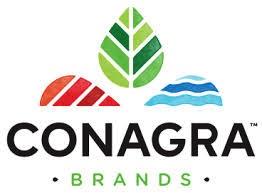 In an April 4th 2024 release, Conagra Brands (CAG) posted financial results for the third quarter of Fiscal 2024 ending February 23rd 2024. The Company can be regarded as representative of the manufacturing and packaged food sector with competitors including Post Holdings, Campbell Soup Company and Kraft-Heinz, all currently under pressure to reduce prices to the major food service providers and supermarket chains. In an inflationary environment consumers are turning to less expensive private brands although the trend to eat-at-home may benefit Conagra Brands and competitors. In an April 4th 2024 release, Conagra Brands (CAG) posted financial results for the third quarter of Fiscal 2024 ending February 23rd 2024. The Company can be regarded as representative of the manufacturing and packaged food sector with competitors including Post Holdings, Campbell Soup Company and Kraft-Heinz, all currently under pressure to reduce prices to the major food service providers and supermarket chains. In an inflationary environment consumers are turning to less expensive private brands although the trend to eat-at-home may benefit Conagra Brands and competitors.
For the third quarter of FY 2024, net income was $308.6 million on net revenue of $3,033 million with a diluted EPS of $0.64. Comparable figures for the third quarter of FY 2023 ending February 26th 2023 were net income of $342.2 million on net revenue of $3,087 million with a diluted EPS of $0.72
The release included results for the four operating segments:-
- Foodservice: Operating profit of $35 million down 48.7 percent from Q3 2023, on revenue of $273 million
- Refrigerated and Frozen: Operating profit of $202 million, down 24 percent, on revenue of $1,200 million
- International: Operating profit of $42 million, up 14 percent on revenue of $272 million
- Groceries and Snacks: Operating profit of $299 million, up 16 percent on revenue of $1,300 million
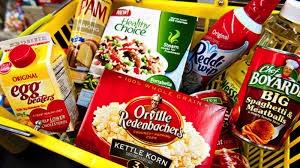 For the third quarter of FY 2024 (with the values for the corresponding quarter of FY 2023 in parentheses) Conagra achieved a gross margin of 28.3 percent (27.2) and an operating margin of 15.6 percent (15.9). Revenue was down 1.8 percent. For the third quarter of FY 2024 (with the values for the corresponding quarter of FY 2023 in parentheses) Conagra achieved a gross margin of 28.3 percent (27.2) and an operating margin of 15.6 percent (15.9). Revenue was down 1.8 percent.
Guidance for FY 2024 included a net sales decline of 1 to 2 percent; an adjusted increase in operating margin of 15.8 percent and an EPS of between $2.60 and $2.65. Capital expenditure was projected at $425 million.
Conagra Brands listed assets of $21,919 million, including a disproportionate $14,261 million as goodwill and intangibles, against long-term debt and other obligations of $9,221 million. The Company had an intraday market capitalization of $14,230 million on April 16th. CAG trades with a forward P/E of 10.9 and has ranged over a 52-week period from $25.16 to $38.75 with a 50-day moving average of $28.69. Twelve-month trailing operating and profit margins were 17.7 percent and 7.9 percent respectively. The Company generated a twelve-month trailing return of 5.3 percent on assets and 10.5 percent on equity.

|
CDC Reports on Salmonellosis Acquired from Backyard Chickens
|
04/18/2024 |
|
 A recent report in the CDC house journal MMWR* documented 1,072 cases of salmonellosis associated with backyard poultry resulting in 247 hospitalizations. Serotypes included S. Braenderup, Enteritidis, Indiana, Infantis, and Typhimurium with multiple states involved. The report also included documentation of S. Thompson in a breastfed neonate who contracted infection within days of returning to a home with his mother after delivery. It is presumed that infection was acquired from environmental contamination or from a shedder of the pathogen within the household. Based on whole genome sequencing, identical isolates were recovered from the infant, the chickens and their environment. A recent report in the CDC house journal MMWR* documented 1,072 cases of salmonellosis associated with backyard poultry resulting in 247 hospitalizations. Serotypes included S. Braenderup, Enteritidis, Indiana, Infantis, and Typhimurium with multiple states involved. The report also included documentation of S. Thompson in a breastfed neonate who contracted infection within days of returning to a home with his mother after delivery. It is presumed that infection was acquired from environmental contamination or from a shedder of the pathogen within the household. Based on whole genome sequencing, identical isolates were recovered from the infant, the chickens and their environment.
The report cautioned personal biosecurity following contact with backyard chickens. Taking into account the incidence rate of chicken acquired salmonellosis and the 24 percent hospitalization rate, it is questioned whether the benefits of maintaining backyard poultry are commensurate with the risk if not inevitability of infection and its consequences.
* Ladd-Wilson SG, et al. Neonatal Salmonellosis Associated with Backyard Poultry. MMWR 73:321-322. (2024)
|

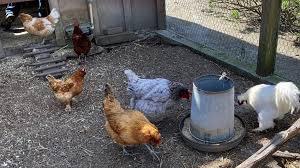 |

|
Self-Checkout Subject to New Obstacles
|
04/18/2024 |
|
 In recent weeks both dollar store chains and Target Corporation have placed restrictions on self-checkout following evident theft and inadvertent errors in scanning. Now state and local legislators have recognized the negative effect on employment by displacing checkout clerks. California Senate Bill 1446 has been reintroduced to require grocery and pharmacy retailers to employ at least one dedicated clerk per two self-checkout stations. This would negate the cost saving that was in fact the objective of the technological innovation. In recent weeks both dollar store chains and Target Corporation have placed restrictions on self-checkout following evident theft and inadvertent errors in scanning. Now state and local legislators have recognized the negative effect on employment by displacing checkout clerks. California Senate Bill 1446 has been reintroduced to require grocery and pharmacy retailers to employ at least one dedicated clerk per two self-checkout stations. This would negate the cost saving that was in fact the objective of the technological innovation.
 Maine is also considering a levy on self-checkout in the form of an obligatory discount since in the words of the proponent of the legislation, the stores are making “customers do the work performed by employees”. It is understood that City of Evanston, IL is considering a special tax of $5,000 on every self-checkout station in a store. Maine is also considering a levy on self-checkout in the form of an obligatory discount since in the words of the proponent of the legislation, the stores are making “customers do the work performed by employees”. It is understood that City of Evanston, IL is considering a special tax of $5,000 on every self-checkout station in a store.
From personal experience, self-checkout is convenient to purchase up to four items but only if all packages are barcoded. Problems occur with food and produce and self-serve floral arrangements. A second problem relates to a wide variation in operation of self-service kiosks. On-screen and audible instructions are often confusing although once familiar with a specific system, bar-coded items can be scanned with the advantage of skipping a congested checkout lane. Aldi should be complemented on their self-scan checkout which is simple to operate and reliable even for non-techie octogenarians.

|
Need to Reassure Consumers over Egg and Milk Safety Over Emerging H5N1 Infections
|
04/17/2024 |
|
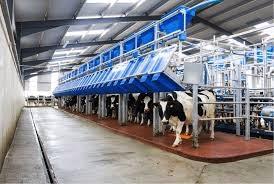 Both mainstream outlets and social media are reporting widely on the emergence of bovine influenza-H5N1 and recent outbreaks of HPAI in egg operations. Both mainstream outlets and social media are reporting widely on the emergence of bovine influenza-H5N1 and recent outbreaks of HPAI in egg operations.
- The dairy industry is confirming safety by stating that milk from affected cows does not enter the supply stream and that in any event pasteurization inactivates influenza virus.
- The situation for eggs is similar. Infection of a flock results in a precipitous drop in egg production and a rapid rise in mortality resulting in rapid diagnosis and withholding of eggs from the market. Cooking eggs will destroy avian influenza virus that does not in any event appear transmissible to consumers through food.
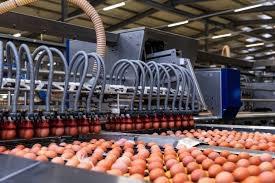 Dr. Barbara Kowalcyk director of the Center for Food Safety and Nutrition Security at George Washington University correctly stated, “Eggs that are handled properly and cooked thoroughly are safe to eat.” Dr. Barbara Kowalcyk director of the Center for Food Safety and Nutrition Security at George Washington University correctly stated, “Eggs that are handled properly and cooked thoroughly are safe to eat.”

|
Foreign-Born U.S. Demographic
|
04/17/2024 |
|

The U.S. Census Bureau released the Foreign-Born Population in the United States: 2022 Report on April 9th. The report includes data on location, education, employment, and health status among forty parameters. The foreign-born cohort includes naturalized citizens, lawful permanent residents, temporary migrants, humanitarian migrants and unauthorized migrants. Collectively these categories represented 13.9 percent of the total population or 46.2 million compared to 12.9 percent or 40.0 million in 2010. States with increases in foreign-born population greater than 40 percent included Delaware, North Dakota, South Dakota and West Virginia. The median age of the foreign-born population increased from 41.4 to 46.7 years compared to the native-born population that increased from 35.9 to 36.9 years of age. In 2022, 75.1 percent of foreign-born residents completed high school or attained higher educational status compared to 68.3 percent in 2010.

Immigrants comprise over 20 percent of the population of California, New Jersey, New York and Florida, ranging from 25.5 percent down to 21.1 percent. Half of the immigrants in the U.S. entered before 2000. Approximately 63 percent of the foreign-born population over the age of 16 was employed, with one-third in management, business or science occupations.

The report suggests that immigrants contribute to the economy of the U.S. and are essential to maintain the population that would otherwise decline. Immigrants in the workforce strengthen social security through their contributions. Without immigrants, payments into the program by an aging and shrinking native-born population of U.S. citizens would require higher contributions or alternatively benefits would have to be reduced to maintain the solvency of the Social Security System.

|
Survey Confirms Consumers Searching for Value in Protein
|
04/17/2024 |
|
 John Cleaver writing in Meating Place noted the report from market survey company 84.51 Inc. relating to the purchase protein foods. The survey determined that 37 percent of consumers are downgrading meat purchases according to unit cost. This has impacted sales of higher-priced organic meat. Approximately 40 percent of consumers surveyed were stretching their protein expenditure by purchasing soups and products to extend inclusion of meat in home-prepared food. Unnecessary food purchases including snacks and high-priced discretionary items are avoided in an attempt to reduce expenditure on food now rising at an annual inflation rate of two percent. John Cleaver writing in Meating Place noted the report from market survey company 84.51 Inc. relating to the purchase protein foods. The survey determined that 37 percent of consumers are downgrading meat purchases according to unit cost. This has impacted sales of higher-priced organic meat. Approximately 40 percent of consumers surveyed were stretching their protein expenditure by purchasing soups and products to extend inclusion of meat in home-prepared food. Unnecessary food purchases including snacks and high-priced discretionary items are avoided in an attempt to reduce expenditure on food now rising at an annual inflation rate of two percent.
 Given that demand for eggs after Easter has not fallen as in previous years it is possible that consumers recognize their nutritional value and are opting for egg dishes as eat-at-home lunch and dinner servings. This is consistent with shoppers searching for value including the use of coupons, buying in bulk from club stores and taking advantage of promotions and discounts. Given that demand for eggs after Easter has not fallen as in previous years it is possible that consumers recognize their nutritional value and are opting for egg dishes as eat-at-home lunch and dinner servings. This is consistent with shoppers searching for value including the use of coupons, buying in bulk from club stores and taking advantage of promotions and discounts.

|
Trader Joe’s Store Fined by OSHA
|
04/17/2024 |
|
 With overtones of recent action against dollar stores, a Trader Joe’s location in Greenwood Village, CO. was fined $200,000 by the Occupational Safety and Health Administration (OSHA). At issue were contraventions of worker safety regulations by a repeat offender. The store was previously cited for blocking access to electrical switchgear, failure to implement a program of training for forklift operators and deficiencies in maintenance. The defects observed at the Colorado store have also been documented at Trader Joe’s locations in five eastern states. With overtones of recent action against dollar stores, a Trader Joe’s location in Greenwood Village, CO. was fined $200,000 by the Occupational Safety and Health Administration (OSHA). At issue were contraventions of worker safety regulations by a repeat offender. The store was previously cited for blocking access to electrical switchgear, failure to implement a program of training for forklift operators and deficiencies in maintenance. The defects observed at the Colorado store have also been documented at Trader Joe’s locations in five eastern states.

In commenting on the action, Chad Vivian, OSHA Area Director for Colorado stated, “Employees must comply with all Federal safety standards including forklift training and keeping areas around electrical equipment clear to prevent injuries and fatal accidents.” He concluded, “We will continue to cite companies that fail to implement the measures necessary to protect their employees from these hazards.”

|
Food Insecurity in the U.S.
|
04/17/2024 |
|
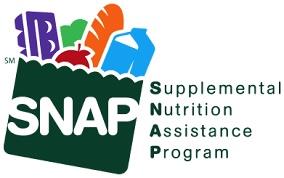 The Bureau of Census and the Economic Research Service of USDA determined the prevalence of food insecurity across ethnic and economic groups in the U.S. A recent report evaluated data from 214,000 households gathered from 2016 through 2021. The prevalence of food insecurity ranges from 5.4 percent for Asian households to 23.3 percent for American Indian and Alaskan native households. This category experienced difficulty in obtaining sufficient food due to lack of disposable income. The Bureau of Census and the Economic Research Service of USDA determined the prevalence of food insecurity across ethnic and economic groups in the U.S. A recent report evaluated data from 214,000 households gathered from 2016 through 2021. The prevalence of food insecurity ranges from 5.4 percent for Asian households to 23.3 percent for American Indian and Alaskan native households. This category experienced difficulty in obtaining sufficient food due to lack of disposable income.
Very low food security was experienced by 1.6 percent of Asian households but up to 11.3 percent for native American-White multiracial households. In this category, food intake was rationed and the number of meals was reduced due to lack of availability. The report also noted diversity within ethnic groups. Food insecurity among Japanese households categorized within the Asian demographic was at 1.7 percent compared to 11.4 percent for other Asian households.
 Among all U.S. households 12 percent were insecure and 4 percent experienced low levels of food security. The highest affected groups comprised Black Americans with 22 percent of households insecure and 8 percent experiencing low food security. White households in contrast showed 7 percent insecurity and 3 percent extremely low food security. Hispanic households were intermediate with 16 percent insecure and 6 percent reporting low food security. Among all U.S. households 12 percent were insecure and 4 percent experienced low levels of food security. The highest affected groups comprised Black Americans with 22 percent of households insecure and 8 percent experiencing low food security. White households in contrast showed 7 percent insecurity and 3 percent extremely low food security. Hispanic households were intermediate with 16 percent insecure and 6 percent reporting low food security.
The extent of food insecurity is an unfortunate reality in a nation with the largest GDP in the world. The magnitude of the problem should be considered in relation to the current conflicts within the House and Senate Agriculture Committees that have failed to produce an acceptable Farm Bill. This is mainly due to division along party lines as to the relative expenditures on SNAP and WIC relative to agricultural support prices.

|
National Fire Protection Association Proposing Sprinkler Systems
|
04/17/2024 |
|
 The National Fire Protection Association has introduced draft standards for installation of sprinkler systems in animal housing. It is noted that there have been a number of fires in layer houses including recently erected units. The National Fire Protection Association has introduced draft standards for installation of sprinkler systems in animal housing. It is noted that there have been a number of fires in layer houses including recently erected units.
The UEP has filed a notice of intent to request deletion of the draft standard. Installation of sprinkler systems would obviously add cost to new housing but might be offset by reduced insurance rates.
 Prism Control Systems has developed the ThERM® Fire Detection and Response System*. A series of sensors detects high temperature and airborne particulates associated with a fire. The system responds by initiating alarms and inactivating fans that accelerate the progress of a fire. Prism Control Systems has developed the ThERM® Fire Detection and Response System*. A series of sensors detects high temperature and airborne particulates associated with a fire. The system responds by initiating alarms and inactivating fans that accelerate the progress of a fire.
With larger house capacity and more expensive construction and installations, it is essential that all new and retrofitted housing conform to safety codes. For new construction, flammability of construction and insulation materials should be considered in addition to selecting fire detection and suppression installations.

*Details of ThERM can be downloaded from the Prism Controls website, accessed by clicking on to the Company logo on the right side of the Welcome page

|
Drought in Mexico to Reduce Corn Yield
|
04/17/2024 |
|
White corn, a carbohydrate staple in Mexico will be impacted by an ongoing drought. The state of Sinaloa that grows white corn in winter is severely impacted according to a USDA spokesperson who has knowledge of the area. Dry conditions prevailed in the fall before planting and soil moisture has deteriorated since the start of the season. Reservoirs in the State have less than 15 percent of their capacity eliminating the possibility of irrigation.

The cost of white corn is a major concern for the Government of Mexico especially in an election year. Inflation in the price of tortillas and other basic foods is inevitable. It is noted that AMLO, the President of Mexico previously issued a decree banning importation of GMO yellow corn for human consumption. There is limited availability of white corn from the U.S. that could supplement supplies in Mexico. This will result in inevitable shortages and higher prices absent Government intervention and support.
|

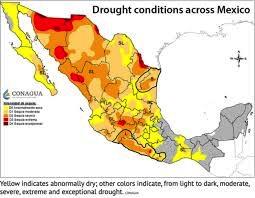
|

|
The Dairy Industry Discovers Biosecurity-Too Little, Too Late?
|
04/17/2024 |
|
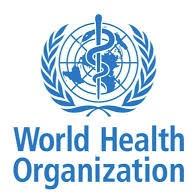 Since late March, 28 cases of bovine influenza-H5N1 (and counting!) have been diagnosed in eight states. To date this has not impacted either total milk supply or prices of fluid milk, based on the negligible reduction in supply. Since late March, 28 cases of bovine influenza-H5N1 (and counting!) have been diagnosed in eight states. To date this has not impacted either total milk supply or prices of fluid milk, based on the negligible reduction in supply.
Without a preliminary epidemiologic study, operators of dairy herds have initiated procedures to limit introduction of infection. Initial observations suggest that H5N1 influenza virus is introduced into the vicinity of herds by domestic wild birds susceptible to the virus including grackles and pigeons as reported for the index farm in Texas.
In the absence of structural and operational biosecurity as used in the poultry industry, dairy herds appear vulnerable. Workers are evidently tracking virus into the vicinity of farms and congregation of animals in close proximity during milking appears to favor animal-to-animal infection. Milking machines may be implicated in direct transmission of virus among cows even to the level of a mammary quarter. The emergence of a single case of human influenza H5N1 in a dairy-herd worker highlights the need for personnel protective equipment.
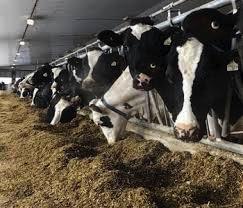 Initial evidence suggests that movement of live animals among states is responsible for wide geographic spread of bovine influenza-H5N1. Accordingly, as many as 17 unaffected states with dairy production have imposed restrictions on movement of live animals from affected areas. Ultimately demonstration of freedom from infection by PCR surveillance will be necessary to allow interstate movement. Initial evidence suggests that movement of live animals among states is responsible for wide geographic spread of bovine influenza-H5N1. Accordingly, as many as 17 unaffected states with dairy production have imposed restrictions on movement of live animals from affected areas. Ultimately demonstration of freedom from infection by PCR surveillance will be necessary to allow interstate movement.
At this time, risk to human populations appears exceptionally low given the fact that only one mild human case has been diagnosed, against the reality of thousands of person-day contacts on affected farms. Milk from infected cows has apparently not entered commercial supply. Pasteurization effectively destroys influenza virus.
Studies are in progress to characterize the H5N1 strain responsible for bovine influenza-H5N1. Mutations have occurred in avian strains of the virus allowing infection of carnivorous animals coming into contact with dead birds. A disquieting series of infections among marine mammals in the U.S. northeast and along the Pacific coast of South America and an outbreak in farmed mink in Spain confirm that mammal-to-mammal infection occurs.
National and international human and veterinary health agencies are monitoring the presence of infection in livestock and assessing the risk for human infection. The World Health Organization is relying on regional influenza reference laboratories to detect the emergence of human infection and the Agency has established contingency plans for a possible pandemic occurrence.
The World Organization of Animal Health is recommending the adoption of preemptive immunization as an adjunct to biosecurity to suppress outbreaks. It is self-evident that concentration of large numbers of commercial poultry in endemic areas represents the potential for mutations and recombinant events, ultimately representing a danger for human populations. This would in large measure be reduced if large egg-production complexes in high-risk areas were to be vaccinated.

|
Regulatory Authorities Prosecuting “Greenwashing”
|
04/16/2024 |
|
 Regulatory authorities on both sides of the Atlantic are evaluating claims of environmental concern by livestock producers. Reports were posted on EGG-NEWS regarding a stay on reporting greenhouse gas emissions by public companies but unrealistic and unsubstantiated claims are receiving attention. In addition to regulatory action, environmental activist organizations are petitioning federal agencies and initiating lawsuits challenging environmental claims such as those advertised by JBS SA. Regulatory authorities on both sides of the Atlantic are evaluating claims of environmental concern by livestock producers. Reports were posted on EGG-NEWS regarding a stay on reporting greenhouse gas emissions by public companies but unrealistic and unsubstantiated claims are receiving attention. In addition to regulatory action, environmental activist organizations are petitioning federal agencies and initiating lawsuits challenging environmental claims such as those advertised by JBS SA.

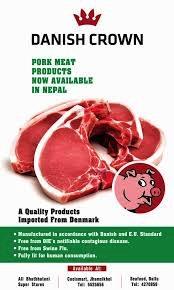 During March 2024, major hog producer Danish Crown admitted to a violation of that nation’s Marketing Act. Their campaign claimed, “Danish pork is more climate-friendly than you think.” When introduced in 2021 the claim was opposed by activists and vegan associations in Denmark and resulted in a cancellation of the campaign. During March 2024, major hog producer Danish Crown admitted to a violation of that nation’s Marketing Act. Their campaign claimed, “Danish pork is more climate-friendly than you think.” When introduced in 2021 the claim was opposed by activists and vegan associations in Denmark and resulted in a cancellation of the campaign.
In a statement following their admission of responsibility, Danish Crown stated, “We now want to look ahead and instead use our efforts on the transition to less climate-damaging production.” The statement added, “We will communicate our climate measures within the framework of the Western High Court decision as well as this affirmative response to the plaintiffs’ claims.”

|
Trucking Industry Experiencing Downturn in Rates and Earnings
|
04/16/2024 |
|
 In contrast to the COVID years and shortly thereafter, freight rates have declined for both negotiated and spot markets. Retailers and distributors are holding inventories at low levels and are aggressive in negotiating prices. In contrast to the COVID years and shortly thereafter, freight rates have declined for both negotiated and spot markets. Retailers and distributors are holding inventories at low levels and are aggressive in negotiating prices.
As with any commodity rates are determined by supply and demand. Trucking capacity now exceeds demand resulting in extreme competition and lower prices. The downward trend will continue until balance is restored according to an analyst at J.P. Morgan.
Since mid-2020, 325,000 carrier units have entered the industry with 231,000 departures. Many trucking companies are burning through accumulated profits earned during the COVID years. The questions are whether rates have now bottomed after the prolonged slump and if there are prospects for increases as retailers restock distribution centers.

|
Ralph Rindler UB Egg Person of the Year
|
04/16/2024 |
|
 Ralph Rindler of Prairie Star Farms was honored as the 2023 Egg Person of the Year at the annual Urner Barry Executive Conference in Las Vegas on Monday April 15th. Ralph Rindler of Prairie Star Farms was honored as the 2023 Egg Person of the Year at the annual Urner Barry Executive Conference in Las Vegas on Monday April 15th.

In presenting the award Randy Pesciotta Egg Reporter for Urner Barry noted “The desire and passion for growth expressed by Ralph has always utilized strong family relationships helping others to become successful along the way,” Randy added “Prairie Star Farms will always have that family feel producing quality eggs with a strong commitment to trusting relationships with everyone they do business with, thanks to the roots that Ralph has established.”
EGG-NEWS extends congratulations to Ralph and Janet on receiving this prestigious award recognizing a career of accomplishment.

|
Responsibility for Food Inflation?
|
04/16/2024 |
|
 The weekly Economic, Energy and Commodity Report in EGG-NEWS details weekly and monthly data released by federal agencies relating to the U.S. economy. Despite the reduction in inflation and the evident deflation in food prices, consumer perceptions erroneously consider what they purchase at the supermarket as a major factor in increasing the cost of living. During the past month, energy costs that have previously contributed to deflation have reversed course with obvious increases at the gas pump. The weekly Economic, Energy and Commodity Report in EGG-NEWS details weekly and monthly data released by federal agencies relating to the U.S. economy. Despite the reduction in inflation and the evident deflation in food prices, consumer perceptions erroneously consider what they purchase at the supermarket as a major factor in increasing the cost of living. During the past month, energy costs that have previously contributed to deflation have reversed course with obvious increases at the gas pump.
Consumers blame “government policies” for high prices of groceries. Conflict in Eastern Europe and the Middle East are contributing to disruption of supply chains and escalation in prices of food items. Consumers have the perception that retail chains are responsible for higher food prices. A survey showed that a sample of shoppers estimated net profits of chains to be in the region of thirty percent whereas, in fact, they range from one to five percent. The accusation of price gouging has become a political issue with unsubstantiated rhetoric by senior officials supported by injudicious statements by the Federal Trade Commission.
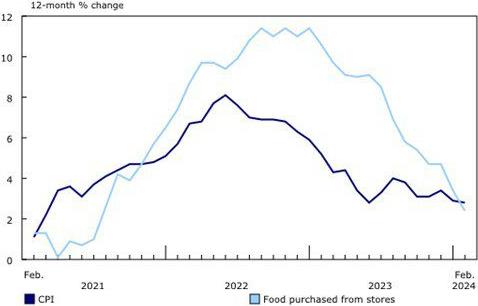 Discontent among consumers will be a major issue in the November General Election. The concurrent concern over the proposed Kroger-Albertsons merger is now playing out against the backdrop of politics. The transaction has now devolved into litigation with individual states and the Federal government opposed to the merger. Discontent among consumers will be a major issue in the November General Election. The concurrent concern over the proposed Kroger-Albertsons merger is now playing out against the backdrop of politics. The transaction has now devolved into litigation with individual states and the Federal government opposed to the merger.
Industry associations representing sectors of the poultry industry should be more aggressive in presenting economic realities to dispel false notions of manipulation of prices and unethical business practices. At the end of the day, consumers do not regard farmers as being responsible for price escalation. This is one comforting consideration in a complex issue with a lot of blame to be assigned.

|
EPA Introduces PFAS Drinking Water Standards
|
04/15/2024 |
|
 After prolonged and detailed review, the Environmental Protection Agency (EPA) has published legally enforceable drinking water standards for per-and-polyfluoroalkyl (PFAS) compounds colloquially referred to as “forever chemicals”. It is estimated that between 6 and 10 percent of 65,000 public drinking water systems will be required to reduce levels of contamination that exceed the published standards. After prolonged and detailed review, the Environmental Protection Agency (EPA) has published legally enforceable drinking water standards for per-and-polyfluoroalkyl (PFAS) compounds colloquially referred to as “forever chemicals”. It is estimated that between 6 and 10 percent of 65,000 public drinking water systems will be required to reduce levels of contamination that exceed the published standards.
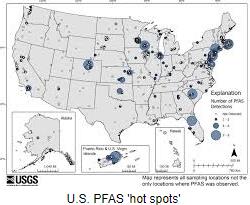
The EPA designated six PFAS compounds as “genX chemicals” with maximum contaminant levels established for individual compounds and their combinations.
Water supply systems will have three years to complete initial monitoring and will then be required to disclose levels of PFAS compounds to consumers. Removal of compounds will be mandated over a five-year period. Current technology capable of removing PFAS compounds from drinking water include filtration through granular activated carbon, reverse osmosis and ion exchange.

In addition to providing technical assistance to water supply systems, $1 billion will be made available to implement testing and treatment with funding derived from the Bipartisan Infrastructure Law.

|
U.S. Greenhouse Gas Emissions Quantified
|
04/15/2024 |
|
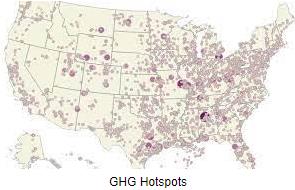 The Environmental Protection Agency prepares an annual inventory of U.S. greenhouse gas emissions that is submitted to the United Nations under the Framework Convention on Climate Change and the Paris Agreement. The Environmental Protection Agency prepares an annual inventory of U.S. greenhouse gas emissions that is submitted to the United Nations under the Framework Convention on Climate Change and the Paris Agreement.
In 2022, net U.S. greenhouse gas emissions totaled 5,489 million metric tons of carbon dioxide equivalents after taking into account sequestration by the land sector. In 2022, emissions increased by one percent mainly from combustion of fossil fuel. This was a result of an increase in economic activity after relaxation of COVID restrictions. Sources of greenhouse gas emissions in 2022 comprised 80 percent carbon dioxide, 11 percent methane, 6 percent nitrous oxide and the remaining 3 percent from a mixture of compounds.
In evaluating sources of greenhouse gas emission by economic sector, agriculture represented 10 percent, industry 30 percent, residential and commercial emitters 31 percent and transportation 30 percent.
Based on the low contribution of the agricultural sector, activists condemning livestock production appear to have missed their target. Perhaps staying up at night while running an air conditioner and writing posts for social media about the evils of meat and poultry production contributed to the residential contribution.

|
Participation in School Feeding Relates to Financial Support
|
04/12/2024 |
|
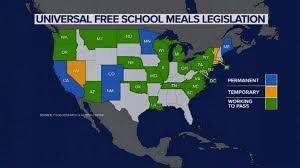 Participation in school feeding programs has declined following the end of federal COVID- period support. A recent report demonstrated that during the 2022-23 school year 28.1 million students participated in school lunch programs. This was six percent less than the number of students participating during the previous academic year. Breakfast participation declined by 7.7 percent with a total of 14.3 million students served. Participation in school feeding programs has declined following the end of federal COVID- period support. A recent report demonstrated that during the 2022-23 school year 28.1 million students participated in school lunch programs. This was six percent less than the number of students participating during the previous academic year. Breakfast participation declined by 7.7 percent with a total of 14.3 million students served.

States that supported school feeding after expiration of federal support noted an increase in both breakfast and lunch servings. An increase in student participation was directly attributed to the Community Eligibility Provision comprising a federal program that allows students to be fed irrespective of income status to avoid “food shaming”.
Investment in school feeding improves attendance and contributes to scholastic progress. Accordingly, many states are expanding access to free school meals. Currently there is a patchwork of reduced-price meals for selected students with an emphasis on elementary grades.
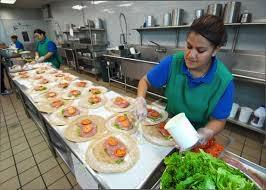 The report called for uniform federal legislation to allow all schools to feed all students free of charge. The report called for uniform federal legislation to allow all schools to feed all students free of charge.

|
CDC Issues Health Alert over Bovine Influenza-H5N1
|
04/12/2024 |
|
 The Centers for Disease Control and Prevention (CDC) issued a health alert on Friday April 5th following the single case of human influenza attributed to H5N1 virus, designated strain 3:13 contracted from dairy cows infected with bovine influenza-H5N1. The health alert was issued to advise physicians and public health workers of the possibility of human influenza-H5N1. The Centers for Disease Control and Prevention (CDC) issued a health alert on Friday April 5th following the single case of human influenza attributed to H5N1 virus, designated strain 3:13 contracted from dairy cows infected with bovine influenza-H5N1. The health alert was issued to advise physicians and public health workers of the possibility of human influenza-H5N1.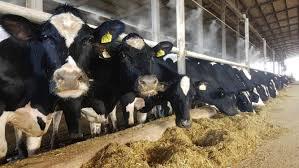
The CDC also reinforced recommendations to use personal protective equipment for workers at risk. The alert also encouraged the monitoring of agricultural workers and those exposed to sick or dead wild and domesticated birds that may have been infected with H5N1 virus.

|
Quaker Oats to Permanently Close Danville, IL. Plant
|
04/12/2024 |
|
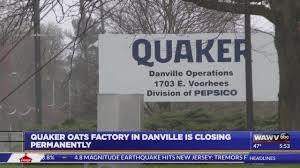 Following a recall of products in December 2023, the Quaker Oats Company a subsidiary of PepsiCo will permanently close the 55-year-old plant and transfer production to other facilities. The recall was due to contamination of granola bars and cereals with Salmonella. A review of the plant indicated the need for extensive refurbishment and installation of new equipment that would have required a prolonged down time. Following a recall of products in December 2023, the Quaker Oats Company a subsidiary of PepsiCo will permanently close the 55-year-old plant and transfer production to other facilities. The recall was due to contamination of granola bars and cereals with Salmonella. A review of the plant indicated the need for extensive refurbishment and installation of new equipment that would have required a prolonged down time.
Brand image and reputation were considerations in the decision to close the plant given the potential for a reoccurrence of infection despite decontamination and upgrading.
 Subscribers are referred to an extensive recall of infant formula from 83 nations in 2017. The product was contaminated with S. Agona resulting in multiple cases and fatalities. The plant involved was located in Craon, France, and was operated by Lactalis, a multinational dairy producer. The plant was out of operation for over a year during cleaning and upgrading of food safety equipment and installations. Subscribers are referred to an extensive recall of infant formula from 83 nations in 2017. The product was contaminated with S. Agona resulting in multiple cases and fatalities. The plant involved was located in Craon, France, and was operated by Lactalis, a multinational dairy producer. The plant was out of operation for over a year during cleaning and upgrading of food safety equipment and installations.

|
States Respond to Outbreaks of Bovine Influenza-H5N1
|
04/12/2024 |
|
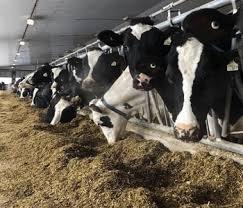 Seventeen states have placed restrictions on introduction of cattle from any of the eight states reporting bovine influenza-H5N1. Effective April 12th diagnosed cases (27) include Texas, Kansas, New Mexico, Idaho, South Dakota, North Carolina, Michigan, and Ohio. Seventeen states have placed restrictions on introduction of cattle from any of the eight states reporting bovine influenza-H5N1. Effective April 12th diagnosed cases (27) include Texas, Kansas, New Mexico, Idaho, South Dakota, North Carolina, Michigan, and Ohio.
Both the U.S. Centers for Disease Control and Prevention and the World Health Organization have issued recommendations based on application of elementary biosecurity to prevent spread and to limit extension to human contacts of cattle. The use of personal protective equipment is advised.
Recommendations by the WHO include enhanced surveillance with reporting of cases especially in unusual hosts through the World Animal Health Information System. Above all,  the World Organization of Animal Health (WOAH) has counseled against implementing “unjustified trade restrictions and import bans” and has advocated adherence to WOAH international standards.” the World Organization of Animal Health (WOAH) has counseled against implementing “unjustified trade restrictions and import bans” and has advocated adherence to WOAH international standards.”
The American Association of Bovine Practitioners has designated the infection as “Bovine Influenza-A” and has established a working group to cooperate with federal and state agencies and to develop biosecurity protocols.

|
Growth in Size of Container Vessels Represents Increased Risk
|
04/12/2024 |
|
 The recent collision of mv Dali with the Francis Scott Key Bridge highlights the size of container vessels and their potential for damage. The accident caused loss of six lives, and as yet uncalculated costs for replacement and the considerable inconvenience including closing of the Baltimore Harbor. Following an inquiry appropriate preventive measures will be issued including the mandatory accompaniment of large vessels by tugs to avert collisions in the event of loss of propulsion The Dali constructed in 2015 as a Super Panamax container carrier has a beam of 158 ft and a length of 984 ft and can carry 10,000 20-ft equivalent container units (TEUs). At the time of the accident, Dali was loaded at over 90 percent capacity. Super Panamax carriers have transited the Panama Canal since 2016 and can be accommodated in ports with a channel of suitable depth and appropriate offloading installations. The largest vessels now afloat can carry up to 24,000 TEUs and are over 1,300 ft in length. The recent collision of mv Dali with the Francis Scott Key Bridge highlights the size of container vessels and their potential for damage. The accident caused loss of six lives, and as yet uncalculated costs for replacement and the considerable inconvenience including closing of the Baltimore Harbor. Following an inquiry appropriate preventive measures will be issued including the mandatory accompaniment of large vessels by tugs to avert collisions in the event of loss of propulsion The Dali constructed in 2015 as a Super Panamax container carrier has a beam of 158 ft and a length of 984 ft and can carry 10,000 20-ft equivalent container units (TEUs). At the time of the accident, Dali was loaded at over 90 percent capacity. Super Panamax carriers have transited the Panama Canal since 2016 and can be accommodated in ports with a channel of suitable depth and appropriate offloading installations. The largest vessels now afloat can carry up to 24,000 TEUs and are over 1,300 ft in length.
 In 1980, the Summit Venture collided with the Sunshine Skyway Bridge near Tampa resulting in 35 fatalities and requiring reconstruction of the bridge with appropriate protective installations. A near collision was avoided this past week when mv Qingdao 1,100 feet in length and 98,000tons, lost propulsion in the Kill van Kull waterway. Three attending tugs together with three other vessels secured the carrier to avoid any possible contact with the Verrazzano-Narrows Bridge. In March 2021, mv Ever Given a 20,000 TEU vessel, 1,300 feet in length blocked the Suez Canal for six days before being refloated. The incident restricted passage through the canal for over 400 vessels resulting in costs exceeding $1 billion. In 1980, the Summit Venture collided with the Sunshine Skyway Bridge near Tampa resulting in 35 fatalities and requiring reconstruction of the bridge with appropriate protective installations. A near collision was avoided this past week when mv Qingdao 1,100 feet in length and 98,000tons, lost propulsion in the Kill van Kull waterway. Three attending tugs together with three other vessels secured the carrier to avoid any possible contact with the Verrazzano-Narrows Bridge. In March 2021, mv Ever Given a 20,000 TEU vessel, 1,300 feet in length blocked the Suez Canal for six days before being refloated. The incident restricted passage through the canal for over 400 vessels resulting in costs exceeding $1 billion.

|
Iowa House Passes Legislation on Meat Labeling and Egg Substitutes
|
04/12/2024 |
|
 Previously the Iowa Senate passed File 2391 establishing labeling restrictions for non-animal derived substitute meat products. Subsequently the House passed the Bill adding an amendment prohibiting purchase of egg substitutes under food assistance programs. Opposition to the amendment in the House was based on depriving recipients of food assistance (SNAP and WIC) from choice in purchasing “fabricated egg products”. Previously the Iowa Senate passed File 2391 establishing labeling restrictions for non-animal derived substitute meat products. Subsequently the House passed the Bill adding an amendment prohibiting purchase of egg substitutes under food assistance programs. Opposition to the amendment in the House was based on depriving recipients of food assistance (SNAP and WIC) from choice in purchasing “fabricated egg products”.
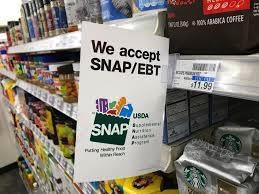 Synthetic plant-based alternatives to real eggs are more expensive and less nutritious than the product they intend to displace. The intent of legislators in the state with the most hens is obviously well founded. The problem arises with individuals who are allergic to eggs and use egg substitutes. As a solution the Iowa Department of Health and Human Services will seek waivers for those with confirmed allergies to purchase alternatives to real eggs. Synthetic plant-based alternatives to real eggs are more expensive and less nutritious than the product they intend to displace. The intent of legislators in the state with the most hens is obviously well founded. The problem arises with individuals who are allergic to eggs and use egg substitutes. As a solution the Iowa Department of Health and Human Services will seek waivers for those with confirmed allergies to purchase alternatives to real eggs.

|
Costco Reports on March Sales
|
04/12/2024 |
|
 For the five weeks ended April 7th, Costco Wholesale Corporation (COST) posted net sales of $23,480 million for the retail month of March compared to $21,460 million for the corresponding five-week period in 2023. Comparable sales, excluding foreign exchange and gasoline, the total company increased same-store sales by 7.5 percent with the U.S. at 7.4 percent, Canada at 7.3 percent and Other International at 8.4 percent. E-commerce increased by 28.0 percent. The retail month of March was impacted by the timing of Easter and accounted for approximately 0.5 percent in For the five weeks ended April 7th, Costco Wholesale Corporation (COST) posted net sales of $23,480 million for the retail month of March compared to $21,460 million for the corresponding five-week period in 2023. Comparable sales, excluding foreign exchange and gasoline, the total company increased same-store sales by 7.5 percent with the U.S. at 7.4 percent, Canada at 7.3 percent and Other International at 8.4 percent. E-commerce increased by 28.0 percent. The retail month of March was impacted by the timing of Easter and accounted for approximately 0.5 percent in comparable sales. comparable sales.
Costco operates 876 warehouses worldwide including 604 in the U.S. and Puerto Rico, 108 in Canada, 40 in Mexico, 33 in Japan, 29 in the U.K. and 62 in Asia, Europe and Australia.

|
Friends of the Earth Campaigning Against Intensive Livestock Production
|
04/12/2024 |
|
 Following the lead of U.K. Environmental and Animal Rights Organizations, Friends of the Earth have initiated a campaign opposing intensive livestock production. The organization is focusing on major banks including JPMorgan, Chase, Citi Group and Bank of America as providing finance for livestock production. Following the lead of U.K. Environmental and Animal Rights Organizations, Friends of the Earth have initiated a campaign opposing intensive livestock production. The organization is focusing on major banks including JPMorgan, Chase, Citi Group and Bank of America as providing finance for livestock production.
Although disguised as a pro-environmental issue to reduce global emissions, the initiative finds common cause with traditional opponents of production of animal meat including groups advocating a vegan lifestyle.

|
USPOULTRY Awards Research Grants
|
04/12/2024 |
|
 The USPOULTRY Foundation has approved research grants that will benefit the egg production sector of the U.S. poultry industry. Funding was approved by the Board of Directors based on recommendations by the Foundation Research Advisory Committee. Grants for projects included: The USPOULTRY Foundation has approved research grants that will benefit the egg production sector of the U.S. poultry industry. Funding was approved by the Board of Directors based on recommendations by the Foundation Research Advisory Committee. Grants for projects included:
- Role of phytase dosage and reduced dietary mineral levels in pullet performance. Mississippi State University
- Poultry house mass depopulation calculator. North Carolina State University
- Advancing infectious coryza diagnosis and control. Iowa State University
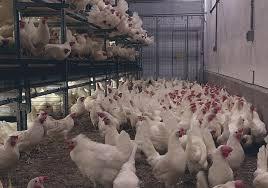 Since inception of the Comprehensive Research Program USPOULTRY has invested more than $36 million in research grants to fifty universities and federal and state institutions Since inception of the Comprehensive Research Program USPOULTRY has invested more than $36 million in research grants to fifty universities and federal and state institutions

|
Target Introduces TruScan at Self-Checkout
|
04/12/2024 |
|
 Faced with deliberate theft and inadvertent errors in scanning, Target Corp has introduced TruScan Technology that integrates overhead cameras with check-out scanners. If an item is not scanned, the customer receives an audio and visual cue, and a store employee is alerted. The technology has been tested in a number of stores with success. At the present time, self check-out is limited to ten items and the Company is adding more conventional check-out lanes manned by clerks. Faced with deliberate theft and inadvertent errors in scanning, Target Corp has introduced TruScan Technology that integrates overhead cameras with check-out scanners. If an item is not scanned, the customer receives an audio and visual cue, and a store employee is alerted. The technology has been tested in a number of stores with success. At the present time, self check-out is limited to ten items and the Company is adding more conventional check-out lanes manned by clerks.
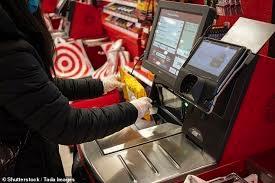
Other supermarket chains, including Harris-Teeter a Kroger banner, are installing cameras above self-checkout stations. The extent of their integration with the scanners is not known.

|
Georgia Opposes U.S. EPA Effluent Guidelines
|
04/12/2024 |
|
 The Attorney General of Georgia, Chris Carr, has joined 26 other Attorneys General to oppose the Effluent Limitations Guidelines proposed by the U.S. Environmental Protection Agency. The Attorney General of Georgia, Chris Carr, has joined 26 other Attorneys General to oppose the Effluent Limitations Guidelines proposed by the U.S. Environmental Protection Agency.
Opposition to the proposed guidelines is based on the high cost of compliance that would increase the price of meat, poultry and egg products to consumers. It is estimated that with the more stringent guidelines, EPA jurisdiction over 150 processing plants would be increased to 3,000 facilities.
The letter submitted by the AGs noted “Evident escalation in the intensity of regulations issued by federal agencies, harms the integrity of our judicial system and this Administration should stop abusing the legal system to achieve results it otherwise cannot get”. Legality of the Effluent Limitations Guidelines is questioned since the proposed rule would extend the statutory authority of the Environmental Protection Agency under the Clean Water Act.

|
Walmart Settles Class-Action Lawsuit
|
04/10/2024 |
|
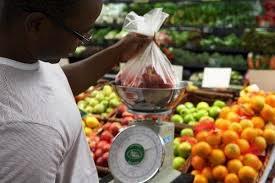 Walmart, Inc. will pay $45 million to settle a class-action lawsuit. The Plaintiffs alleged incorrect charging of customers purchasing meat and produce by weight. The 2022 filing claimed that Walmart apparently overcharged for meat products that were advertised at rollback prices that were not offered at checkout. Walmart, Inc. will pay $45 million to settle a class-action lawsuit. The Plaintiffs alleged incorrect charging of customers purchasing meat and produce by weight. The 2022 filing claimed that Walmart apparently overcharged for meat products that were advertised at rollback prices that were not offered at checkout.

Walmart settled the case “to avoid the uncertain outcome of a jury trial and to limit costs of litigation”. The company denied misleading customers.
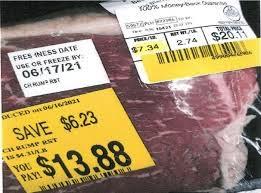
According to the settlement, consumers who consider that they may have been overcharged are requested to file claims to receive compensation. The one absolute in this case is that the lawyers representing the class will have first pick at the proceeds.

|
San Francisco Ordinance To Requiring Notice Before Closing a Grocery Store
|
04/10/2024 |
|
 In yet another example of California anti-business bias, the City of San Francisco intends to enact an ordinance requiring grocery stores to give six months’ notice before closing. In addition, it will be necessary to search for a replacement and to interact with the impacted community. The proposed ordinance was originally considered in 1984 but was vetoed by the then Mayor Dianne Feinstein exercising sound judgment. In yet another example of California anti-business bias, the City of San Francisco intends to enact an ordinance requiring grocery stores to give six months’ notice before closing. In addition, it will be necessary to search for a replacement and to interact with the impacted community. The proposed ordinance was originally considered in 1984 but was vetoed by the then Mayor Dianne Feinstein exercising sound judgment.
As in the case of Chicago, grocery chains that attempted to provide retail service to consumers in so-called ‘food deserts’ have been afflicted with theft and operate in dangerous environments. Criminal activity in these high-risk areas including downtown appear to be beyond the control of police and the judicial system.
 The proposed ordinance is another case of California elected officials spending other people’s money and creating an unattractive business environment. Supervisor, Dean Preston, has led the charge to resurrect the 1984 ordinance, stating, “Food insecurity is on the rise especially for seniors and families as food prices skyrocket and food programs face major cuts.” Preston would generate greater benefits to his constituents by encouraging community support, eliminating crime and providing civic services to retailers to encourage them to maintain functional operations. The proposed ordinance is another case of California elected officials spending other people’s money and creating an unattractive business environment. Supervisor, Dean Preston, has led the charge to resurrect the 1984 ordinance, stating, “Food insecurity is on the rise especially for seniors and families as food prices skyrocket and food programs face major cuts.” Preston would generate greater benefits to his constituents by encouraging community support, eliminating crime and providing civic services to retailers to encourage them to maintain functional operations.

|
SEC to Place Climate Disclosure Rules on Hold Following Legal Challenges
|
04/10/2024 |
|
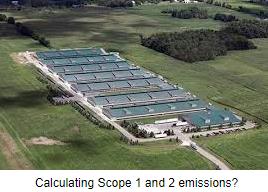  The Securities and Exchange Commission (SEC) will place on hold the imposition of proposed climate disclosure rules. Opponents claim that the requirements exceed the authority of the Agency with respect to disclosure of Scope One and Scope Two emissions. The SEC originally required disclosure of Scope Three emissions for which reporting would be extremely difficult if not impossible for many companies including food producers. The Securities and Exchange Commission (SEC) will place on hold the imposition of proposed climate disclosure rules. Opponents claim that the requirements exceed the authority of the Agency with respect to disclosure of Scope One and Scope Two emissions. The SEC originally required disclosure of Scope Three emissions for which reporting would be extremely difficult if not impossible for many companies including food producers.

|
Northland Boom Introduces E-Drive Vaccinator
|
04/10/2024 |
|
 Northland Boom Custom Spray has designed the E-Drive aerosol vaccinator to administer vaccines by the spray route in both cage and aviary systems. The new model is self-propelled reducing the time required to immunize flocks and was developed in collaboration with egg producers. Northland Boom Custom Spray has designed the E-Drive aerosol vaccinator to administer vaccines by the spray route in both cage and aviary systems. The new model is self-propelled reducing the time required to immunize flocks and was developed in collaboration with egg producers.
 Based on practical experience and application, the E-Drive Vaccinator incorporates a shield to deflect birds from the front of the unit as it transits between modules. Based on practical experience and application, the E-Drive Vaccinator incorporates a shield to deflect birds from the front of the unit as it transits between modules.
The E-Drive Vaccinator incorporates a single boom that can be customized according to the number of tiers and their height. The unit incorporates two batteries. One powers the drive motor and the other energizes the compressor and other functions.
The unit is capable of distributing droplet sizes from 20-200 microns depending on the selection of nozzles. Fine to coarse adjustment of the unit is possible during operation. The delivery rate ranges from 4 to 28 gallons per hour depending on nozzle delivery
Each unit is customized for intended operation and is covered by a warranty.
A demonstration model will be on display at the Northland Boom Booth # 735 at the PEAK Exhibition

|
Diagnostic Centers Investigating Bovine Influenza-H5N1
|
04/09/2024 |
|
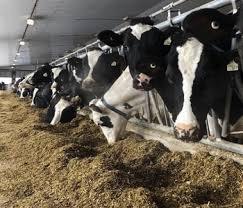 Dr. Diego Diel, Director of the Virology Laboratory at the Animal Health Diagnostic Center at the Cornell University College of Veterinary Medicine, will undertake molecular and epidemiologic studies on emerging Bovine Influenza-H5N1. He noted, “We will study how HPAI spilled over into dairy cows to understand why these outbreaks happened.” He added, “There are a number of very important questions about its source and the risk of transmission to other animals and humans that need to be addressed. It is noted that diagnosticians at the Cornell Diagnostic Center identified H5N1 influenza virus in specimens submitted from an affected herd in Texas. The Center was prompted to examine for avian influenza virus following reports that dead grackles and sick cats accompanied the outbreak of the then undiagnosed condition in dairy cows characterized by an acute decline in milk yield, anorexia and mild respiratory signs. Dr. Diego Diel, Director of the Virology Laboratory at the Animal Health Diagnostic Center at the Cornell University College of Veterinary Medicine, will undertake molecular and epidemiologic studies on emerging Bovine Influenza-H5N1. He noted, “We will study how HPAI spilled over into dairy cows to understand why these outbreaks happened.” He added, “There are a number of very important questions about its source and the risk of transmission to other animals and humans that need to be addressed. It is noted that diagnosticians at the Cornell Diagnostic Center identified H5N1 influenza virus in specimens submitted from an affected herd in Texas. The Center was prompted to examine for avian influenza virus following reports that dead grackles and sick cats accompanied the outbreak of the then undiagnosed condition in dairy cows characterized by an acute decline in milk yield, anorexia and mild respiratory signs.
Dr. Louise Moncia of the University of Pennsylvania School of Veterinary Medicine noted that sequencing of the genome of the diary cow isolates confirmed sequences corresponding to isolates from wild birds in the vicinity of the index farm. The gene sequences of the isolates from a Minnesota goat herd diagnosed in late March were similar to an isolate from pheasants in Colorado.
Based on the single case of human infection resulting in conjunctivitis, the Centers for Disease Control and Prevention are actively investigating characteristics of the virus with specific interest in possible changes in genes among avian and ruminant H5N1viruses with respect to the human isolate. According to a CDC release, a change in PB2 E67K was present and associated with adaptation of the avian precursor to mammalian hosts. Even though changes have occurred in this genetic marker, there is no evidence of the potential to infect humans and with a high probability that human-to-human transmission will not occur.
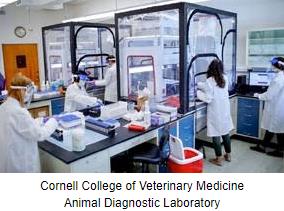
Epidemiologists have noted that the single patient who worked on the affected dairy farm showed only mild conjunctivitis. This could mean that in the future infections might not be recognized and will not be diagnosed providing an opportunity for the virus to adapt to humans. The University of Minnesota is urging dairy farmers to apply common sense precautions to prevent exposure including the use of protective personal equipment for workers in contact with milking cows, raw milk and calves. The University Moos Room Podcast urged farmers to report illness among themselves and their workers, especially those not conversant in English to detect any possible cases of transmission from herds.
On a more optimistic note, scientists at the CDC noted correspondence between the hemagglutinin gene from the virus isolated from the patient with two candidate vaccine viruses that could be used to produce a specific vaccine. The neuraminidase gene of the isolate from the human case was devoid of resistance markers that will allow antiviral drugs including oseltamivir to be administered as an effective therapeutic agent.

|
$1.5 Billion Available for Conservation and Climate Related Projects
|
04/09/2024 |
|
 On April 3rd, Tom Vilsack, secretary of agriculture announced that $1.5 billion will be available in fiscal 2024 for conservation and climate-related projects. Funding available through the Regional Conservation Partnership Program is intended to expand conservation of ranch land and forests with the ultimate intent of modulating climate change. In an address to producers in Minnesota, Secretary Vilsack stated, “We had unprecedented demand for the Regional Conservation Partnership Program last year showing the robust interest in conservation from farmers and ranchers.” He added, “We are looking forward to seeing what the more streamlined and customer-oriented Regional Conservation Partnership Program can do to get more conservation on the ground in the coming months and years.” On April 3rd, Tom Vilsack, secretary of agriculture announced that $1.5 billion will be available in fiscal 2024 for conservation and climate-related projects. Funding available through the Regional Conservation Partnership Program is intended to expand conservation of ranch land and forests with the ultimate intent of modulating climate change. In an address to producers in Minnesota, Secretary Vilsack stated, “We had unprecedented demand for the Regional Conservation Partnership Program last year showing the robust interest in conservation from farmers and ranchers.” He added, “We are looking forward to seeing what the more streamlined and customer-oriented Regional Conservation Partnership Program can do to get more conservation on the ground in the coming months and years.”

Priorities for 2024 include “climate-smart agriculture”, conservation and environmental justice, all priorities of the current Administration and reflecting an emphasis on disadvantage and minority communities.
$1.5 billion is a large sum to be distributed in small amounts to a large number of recipients. One is reminded of the comment by the late Hubert Humphrey that “a billion here and a billion there and it soon adds up to real money.” It is probably incidental that the USDA announcement was made in the home state of the late Senator and Vice President.
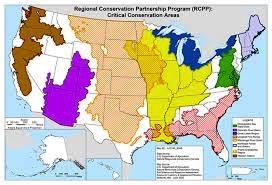
Given the nebulous objectives associated with $1.5 billion in grants, taxpayers are entitled to an accounting with quantitative evaluation of returns. Is this too much to ask? Is this expenditure supposedly for climate change actually an exercise in altruistic social engineering?

|
Trade Mission to Korea A Success
|
04/09/2024 |
|
The recent trade mission led by Alexis M. Taylor, USDA Undersecretary for Trade and Foreign Agricultural Affairs, should be considered a success. More than six hundred meetings with potential importers were arranged. U.S. companies reported $67 million in orders to be filled during the coming twelve months. The population of South Korea now at 50 million offers an opportunity for exports of U.S. agricultural products.
For the first two months of 2024, South Korea imported 635 metric tons of egg products valued at $2.5 million. Exports were up 177 percent in volume and 92 percent in value over the corresponding first two months of 2023. This is in part due to demand over the Lunar New Year and limited supply of shell eggs and products following depletion of flocks as a result of outbreaks of HPAI.
|

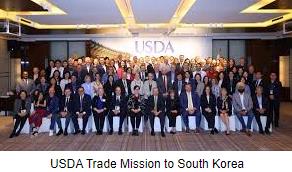
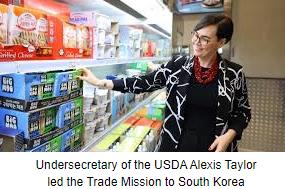 |

|
ADM Animal Nutrition Recalls Wide Range of Feeds
|
04/08/2024 |
|
 According to an April 3, 2024, FDA release, ADM Animal Nutrition has recalled diets for chicken, hogs, cattle, and horses. Problems involved excessive quantities of magnesium, sodium chloride or calcium in diets, potentially resulting in deleterious outcomes. ADM responded to customer complaints, confirming incorrect specifications resulting in recalls. According to an April 3, 2024, FDA release, ADM Animal Nutrition has recalled diets for chicken, hogs, cattle, and horses. Problems involved excessive quantities of magnesium, sodium chloride or calcium in diets, potentially resulting in deleterious outcomes. ADM responded to customer complaints, confirming incorrect specifications resulting in recalls.
Diets were produced in the Quincy, IL plant and were marketed in numerous states through distributors.
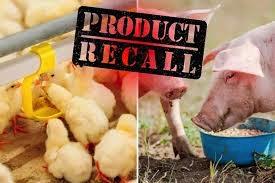
The wide range of diets implicated and the apparent inclusion of high levels of diverse ingredients suggests deficiencies in plant operation including mixing and in quality control.
The FDA released specified trade names for the affected bagged feeds.

|
Updated National Organic Program Handbook
|
04/08/2024 |
|
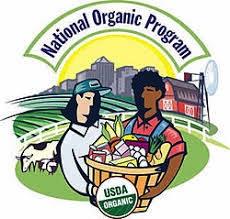 The USDA has released an updated version of the National Organic Program Handbook. This document includes a list of accredited certifiers, guidance, and policy documents. The USDA has released an updated version of the National Organic Program Handbook. This document includes a list of accredited certifiers, guidance, and policy documents.

The 2024 Program Handbook includes a list of updated and archived documents, citations for the information of organic producers.

|
Hamlet Protein Sponsors American Society of Animal Science Program
|
04/08/2024 |
|
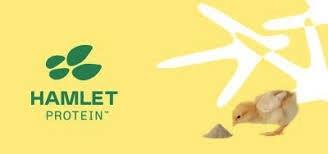
Hamlet Protein was a corporate sponsor of the Midwest Section Meeting of the American Society of Animal Science (ASAS). The event held from March 10th through 13th included a presentation by Dr. Megan Bible on protein kinetics.
Grady Fain, Regional Director for North and Central America for Hamlet Protein noted, “we are proud to be sponsoring the annual meeting of ASAS. The event offers a wonderful opportunity to engage with opinion leaders, industry friends and customers and keep abreast of the most recent scientific developments in our market”.
 Dr. Megan Bible, a presenter observed “Knowing the protein kinetics of an ingredient allows nutritionist to formulate diets with a higher protein biological value optimizing performance and therefore lower feed cost”. Dr. Megan Bible, a presenter observed “Knowing the protein kinetics of an ingredient allows nutritionist to formulate diets with a higher protein biological value optimizing performance and therefore lower feed cost”.
Hamlet Protein manufactures a soybean-based protein ingredient for poults, chicks, and piglets with plants in Denmark and the U.S. distributed worldwide.

|
Cargill Progress in Transitioning to Renewable Energy
|
04/08/2024 |
|
 Cargill has a commitment to reduce greenhouse gas emissions by 10 percent before 2025. To date, based on a 2017 baseline, the Company has achieved a reduction of 11 percent. Cargill is contracting with suppliers of renewable energy through 15 projects using purchase agreements and virtual power purchase agreements. Cargill has a commitment to reduce greenhouse gas emissions by 10 percent before 2025. To date, based on a 2017 baseline, the Company has achieved a reduction of 11 percent. Cargill is contracting with suppliers of renewable energy through 15 projects using purchase agreements and virtual power purchase agreements.  The program extends across twelve countries where Cargill has a presence. The program extends across twelve countries where Cargill has a presence.
Recently, five new transactions were concluded adding 300 megawatts of either wind or solar capacity to extend the renewable energy portfolio to 716 megawatts.

|
U.S. Fish and Wildlife Service Plan to Eradicate Barred Owls
|
04/08/2024 |
|
 The Barred Owl, a native species to the U.S., is encroaching on the habitat of the Spotted Owl in the Pacific Northwest endangering the native species. The U.S. Fish and Wildlife Service intend to kill up to 500,000 Barred Owls by 2055 in an attempt to restore the balance between the species. The Barred Owl, a native species to the U.S., is encroaching on the habitat of the Spotted Owl in the Pacific Northwest endangering the native species. The U.S. Fish and Wildlife Service intend to kill up to 500,000 Barred Owls by 2055 in an attempt to restore the balance between the species.
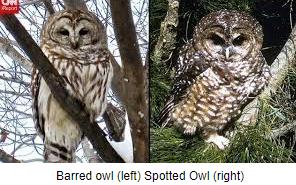
Eighty-five organizations including the Audubon Society have expressed opposition to the proposal. Killing a vast quantity of Barred Owls that closely resemble the species they wish to preserve will inevitably result in misidentification in depopulation. The Agency is urged to either find an alternative solution to protect Spotted Owls or as the Los Angeles Times editorialized “Let nature take its course and leave it to the owls.” The editorial also questioned the ethics and justification of conserving one species by the killing of another.

|
Shrimp from India Contravenes Health and Labor Standards
|
04/08/2024 |
|
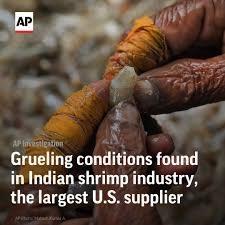 NBC News has publicized the allegations of Joshua Farinella previously employed in the shrimp industry in India concerning injudicious use of antibiotics and coercive labor practices by exporters of shrimp from India. Farinella has elicited interest in Congress regarding unfair competition by shrimp producers in Asia and specifically India. NBC News has publicized the allegations of Joshua Farinella previously employed in the shrimp industry in India concerning injudicious use of antibiotics and coercive labor practices by exporters of shrimp from India. Farinella has elicited interest in Congress regarding unfair competition by shrimp producers in Asia and specifically India.

Representative Mary Peltola (D-AK) and Representative Garret Graves (R-LA) have addressed a letter to the White House alleging, “These foreign producers deliberately use government subsidies and shortcuts- like packing the supply with banned antibiotics or using feed obtained through illegal, unreported and unregulated fishing practices to undercut domestic shrimp suppliers and flood the American market with cheap and unsafe shrimp.” Currently, Congress is reviewing H.R. 4547, the Law Ensuring Safe Shrimp (LESS) Act that will intensify action by the FDA to monitor imported shrimp. This Agency inspected only one percent of shrimp imports for the presence of antibiotics in 2023. In comparison, the E.U. Food Safety Agency recognizes the need to inspect half of all imports.
Allegations by Farinella concerning the exploitation of workers were confirmed independently by the Corporate Accountability Lab. Practices include forced labor, debt bondage and employing child labor.
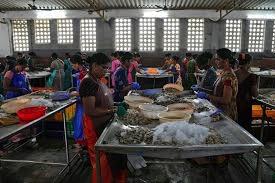
Representatives of companies importing and selling shrimp from India maintain that their corporate policies prohibit forced labor or unsafe working conditions and they have committed to respond to reports of unsafe product and violations of international labor standards.

|
World Escalation in Food Prices
|
04/08/2024 |
|
On April 5th the United Nations Food and Agricultural Organization released the Index of Food Commodities for March 2024. A sequential 12-month reduction in food prices is evidenced by the 7.7 percent decrease in the Index from 131.1 in February 2023 to the most recent value of 118.3 but the Index was up 1.1 percent from the previous month.
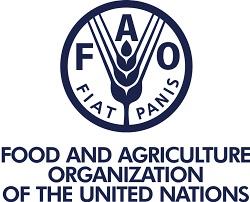
Component indices included:-
- The Meat index in March was up 1.7 percent from February to 113.0 points with higher poultry, pork and beef prices due to Easter demand but with lower prices for ovine products due to increased supply from Australia.
- The Cereal Index was down 2.6 percent from February to 110.8 points due to lower rice, wheat and barley prices but offset by an increase in corn.
- The Vegetable Oil Index was up a noteworthy 8.0 percent from February to 130.6 points with higher prices for palm, soy and sunflower oils on increased demand and diversion to biodiesel in the U.S. and Brazil.
- The Dairy Index was up 2.9 percent from February to 113.0 points
Boutiful crops in Brazil and Argentina with restoration of Black Sea shipping using the ‘Humanitarian Corridor’ have collectively reduced concern over availability of grains and oilseeds and contributed to a moderation in prices for grain and oilseed commodities.
|
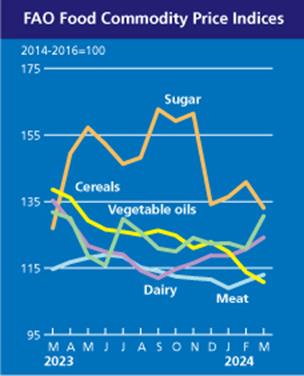
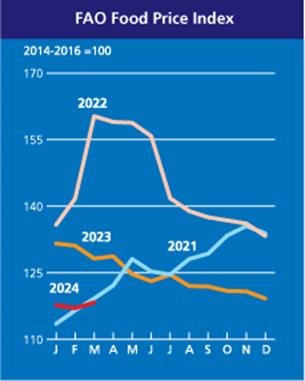
|

|
A Workaround for Key Bridge Collapse
|
04/06/2024 |
|
 Coast guard Captain David O’Connell, Commander of the Maryland-National Capital Region announced the opening of a temporary channel under the collapsed Francis Scott Key bridge. With a draught of 12 foot, a 264 foot horizontal opening and a 96 foot vertical clearance the temporary channel would allow passage of relatively small, commercially essential vessels. Coast guard Captain David O’Connell, Commander of the Maryland-National Capital Region announced the opening of a temporary channel under the collapsed Francis Scott Key bridge. With a draught of 12 foot, a 264 foot horizontal opening and a 96 foot vertical clearance the temporary channel would allow passage of relatively small, commercially essential vessels.

Removal of wreckage in the Patapsco River is in progress but will take weeks before there is free passage to the Port of Baltimore. Using floating cranes and barges responders are removing containers from the mv Dali in preparation from freeing the vessel from the tangled wreckage of the bridge.

|
USDA-Foreign Agricultural Service Announces Funding Opportunities for Exports
|
04/05/2024 |
|
 USDA-Foreign Agricultural Service (FAS) administers four market promotion programs relevant to poultry. Applications are now due for FY 2025 with an application deadline of June 14, 2024. USDA-Foreign Agricultural Service (FAS) administers four market promotion programs relevant to poultry. Applications are now due for FY 2025 with an application deadline of June 14, 2024.

The programs include: -
- Market Access Program – This is a competitive cost-share program for exporters to promote international sales
- The Foreign Market Development Program assists trade associations to build long-term international demand.
- The Quality Samples Program allows trade organizations to provide samples of products to prospective importers.
- The Emerging Markets program supports technical assistance activities to develop emerging markets for livestock and agricultural products.
Details are available on <www.FAS.USDA.Gov/Programs>

|
Nestle Purina PetCare Opens Production Facility in Eden, NC.
|
04/05/2024 |
|
 Nestle Purina PetCare has inaugurated a plant to produce pet food in Eden, NC. The project involved conversion of an existing brewery at a cost $450 million over three years. Nestle Purina PetCare has inaugurated a plant to produce pet food in Eden, NC. The project involved conversion of an existing brewery at a cost $450 million over three years.

Will Steiner manager of the new facility stated, “We have been looking forward to this day for a very long time and are so grateful for the contributions of so many incredible associates who have been working hard to bring this factory to life.” He continued, “What is most exciting is we can now really get to work and produce many of our brands that pets love and owners trust.”
The inaugural event was celebrated with a $30,000 donation to the Rockingham Community College to support a center for workforce development and $7,000 to the Dan River Basin Association that encourages pets and people to explore nature together. Additional donations were made to the Rockingham County Veteran’s Park and the County animal shelter and the Canine Officer for the Eden police force.

|
Retirement of Jeff Hardin
|
04/05/2024 |
|
 Jeff Hardin, Senior Vice-President of Sales for Cal-Maine Foods will retire after a long career with the company. He will be succeeded by Scott Hull, Vice-President of Sales, with immediate effect. Jeff will continue to assist Scott through a transition period. Scott Hull joined Cal-Maine Foods in 2009 and served as General Manager of the Louisburg, NC. complex before joining the sales team as National Sales Manager in 2014. Jeff Hardin, Senior Vice-President of Sales for Cal-Maine Foods will retire after a long career with the company. He will be succeeded by Scott Hull, Vice-President of Sales, with immediate effect. Jeff will continue to assist Scott through a transition period. Scott Hull joined Cal-Maine Foods in 2009 and served as General Manager of the Louisburg, NC. complex before joining the sales team as National Sales Manager in 2014.
Sherman Miller, President and CEO stated, “Jeff Hardin has been an outstanding sales leader for Cal-Maine Foods, and we are extremely grateful for his 36 years of dedicated service. He has developed strong working relationships with our valued  customers and provided exceptional service and support that are hallmarks of Cal-Maine Foods. Scott Hull assumes additional sales leadership responsibilities and has demonstrated his ability to lead our sales efforts.” customers and provided exceptional service and support that are hallmarks of Cal-Maine Foods. Scott Hull assumes additional sales leadership responsibilities and has demonstrated his ability to lead our sales efforts.”
EGG-NEWS joins the U.S. egg-production community in wishing Jeff a happy and contented retirement that is well earned.

|
Amazon to Phase Out Autonomous Check Out
|
04/05/2024 |
|
 The extensively promoted “Just Walk Out” installations in Amazon Fresh and Amazon Go locations will be removed. As with self-checkout, consumer resistance resulted in the change in policy. An Amazon spokesperson stated, “We have invested a lot of time redesigning a number of our Amazon Fresh stores over the last year, offering a better, overall shopping experience with more value and convenience.” The statement continued, “We have also heard from customers that while they enjoyed the benefit of skipping the checkout line with “Just Walk Out”, they wanted the ability to easily find products and deals and view their receipt as they shop.” The extensively promoted “Just Walk Out” installations in Amazon Fresh and Amazon Go locations will be removed. As with self-checkout, consumer resistance resulted in the change in policy. An Amazon spokesperson stated, “We have invested a lot of time redesigning a number of our Amazon Fresh stores over the last year, offering a better, overall shopping experience with more value and convenience.” The statement continued, “We have also heard from customers that while they enjoyed the benefit of skipping the checkout line with “Just Walk Out”, they wanted the ability to easily find products and deals and view their receipt as they shop.”

Amazon will continue to sell the technology to third party users and will retain the systems in Amazon Go stores in the U.K. Amazon.
Dash carts with electronic features that allow customers to monitor purchases and to skip the checkout line will be retained.

|
USDA Now Involved in Reviewing Foreign Purchase of Agricultural Land
|
04/05/2024 |
|
 Provisions to prevent “hostile” nations form acquiring agricultural land in the U.S. are incorporated in the USDA appropriations for fiscal year 2024. The Secretary of Agriculture will now be a member of the Committee on Foreign Investment in the United States and will participate in implementing the Agricultural Foreign Investment Disclosure Act of 1978. An allotment of $2 million was assigned to the USDA to fulfill this obligation. Provisions to prevent “hostile” nations form acquiring agricultural land in the U.S. are incorporated in the USDA appropriations for fiscal year 2024. The Secretary of Agriculture will now be a member of the Committee on Foreign Investment in the United States and will participate in implementing the Agricultural Foreign Investment Disclosure Act of 1978. An allotment of $2 million was assigned to the USDA to fulfill this obligation.
The strengthening of oversight of purchases of agricultural land by foreign nations is the result of a U.S. Government Accountability Office review and report conducted in January 2024 that criticized the USDA for collecting data that was not adequately shared with the CFIUS. Five recommendations made by the GAO were accepted by USDA and will be implemented.
In 2021, EGG-NEWS reported on the intended purchase of a specific tract of land by China ostensibly to erect a corn milling facility that was initially welcomed by the local community. This intended transaction was ignored by the CFIUS, notwithstanding the fact that the intended purchase was located in close proximity to the Grand Forks Air Force Base. The U.S. Air Force vigorously opposed the purchase and the resulting publicity resulted in termination of the intended project.
At the end of 2022 close to 43 million acres or 3.4 percent of U.S. agricultural acreage was owned by foreign entities. Canadian companies owned 32 percent of this amount mostly as forests. Agricultural tracts were owned by the Netherlands (6 percent); Italy, Germany and the U.K. (5 percent each) Japan, (1.5 percent) and China, (1 percent) mostly through acquisition of Smithfield Foods. Concern has been expressed over potential purchases by unfriendly nations including the Peoples Republic of China, Iran, the Russian Federation and more unlikely North Korea and Venezuela.

|
USDA Fertilizer Production Program Expanded
|
04/05/2024 |
|
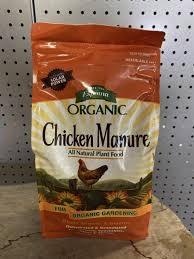 The USDA has assigned more than $174 million to 42 projects nationwide to increase production of fertilizer. Projects include installations to dry and decontaminate animal waste that can be used as a fertilizer. Grants included improvements in infrastructure and business development in rural areas including tribal and low-income areas. The USDA has assigned more than $174 million to 42 projects nationwide to increase production of fertilizer. Projects include installations to dry and decontaminate animal waste that can be used as a fertilizer. Grants included improvements in infrastructure and business development in rural areas including tribal and low-income areas.
 The Fertilizer Production Expansion Program could subsidize manure-drying installations for egg production units. Some complexes of over 500,000 hen capacity have installed rotary dryers to convert waste from either high-rise houses or belt collection systems to a valuable organic fertilizer for agricultural, commercial and domestic uses. Subscribers are directed to Uzelac Industries for technical information and financial projections. The Uzelac website can be accessed by clicking onto the company logo on the right side of the Welcome page. The Fertilizer Production Expansion Program could subsidize manure-drying installations for egg production units. Some complexes of over 500,000 hen capacity have installed rotary dryers to convert waste from either high-rise houses or belt collection systems to a valuable organic fertilizer for agricultural, commercial and domestic uses. Subscribers are directed to Uzelac Industries for technical information and financial projections. The Uzelac website can be accessed by clicking onto the company logo on the right side of the Welcome page.

|
2024 National Trade Estimate Report on Foreign Trade Barriers
|
04/05/2024 |
|
 Each year the Trade Representative of the U.S. is required to submit a report to Congress on barriers to trade and investment that disadvantage domestic companies. The 2024 report under signature of, Ambassador Katherine Tai, U.S. Trade Representative (USTR), identified significant barriers to exports of U.S. agricultural products. These included opaque and burdensome facility registration requirements, nonscientific barriers based on sanitary measures, failure to recognize approval of established biotechnology with reference to the E.U. and Mexico. Unjust restrictions as a result of local or regional outbreaks of highly pathogenic avian influenza (HPAI) have impeded exports to many nations including the People’s Republic of China that in any event has endemic HPAI of diverse strains. Each year the Trade Representative of the U.S. is required to submit a report to Congress on barriers to trade and investment that disadvantage domestic companies. The 2024 report under signature of, Ambassador Katherine Tai, U.S. Trade Representative (USTR), identified significant barriers to exports of U.S. agricultural products. These included opaque and burdensome facility registration requirements, nonscientific barriers based on sanitary measures, failure to recognize approval of established biotechnology with reference to the E.U. and Mexico. Unjust restrictions as a result of local or regional outbreaks of highly pathogenic avian influenza (HPAI) have impeded exports to many nations including the People’s Republic of China that in any event has endemic HPAI of diverse strains.
Ambassador Tai noted “The USTR is determined to use all available tools to ensure that U.S. agricultural producers are provided fair access to compete on a level playing field globally.”
 The report highlighted the lack of uniformity among nations in the European Union. Different policies are imposed across member states including labeling, agriculture biotechnology, packaging and intellectual property. The competitiveness of U.S. industries is threatened by subsidies, financial support and other preferences and policies to the advantage of foreign goods. The report highlighted the lack of uniformity among nations in the European Union. Different policies are imposed across member states including labeling, agriculture biotechnology, packaging and intellectual property. The competitiveness of U.S. industries is threatened by subsidies, financial support and other preferences and policies to the advantage of foreign goods.
The office of the USTR constantly evaluates situations to determine whether barriers are based on legitimate scientific and public concerns or are unjustified barriers to free trade. In the event of unjust obstruction to U.S. imports, the USTR initiates action through the World Trade Organization and for specific barriers including dairy exports to Canada and GM corn to Mexico, through the appeals processes allowed under the USMCA Trade Pact.

|
USDA Assigns $120 Million for Rural Energy Programs
|
04/05/2024 |
|
 In a March 28th announcement, the U.S. Department of Agriculture announced an infusion of $120 million into the Rural Energy for American Program (REAP) to fund 541 projects. Improvement in infrastructure through the REAP included: In a March 28th announcement, the U.S. Department of Agriculture announced an infusion of $120 million into the Rural Energy for American Program (REAP) to fund 541 projects. Improvement in infrastructure through the REAP included:
- Installation of wind turbines at a grain storage facility in Nebraska generating 138,000 kilowatt hours per year.
- A biomass furnace to be installed by an Idaho facility to replace obsolete equipment
- A Maine farm will be able to install a roof-mounted solar system generating 50,000 kWh annually.

USDA has assigned $1.8 billion to the REAP program for more than 6,000 renewable energy projects to lower costs, generate income and improve resiliency.
As with many USDA projects under the current Administration it is questioned whether there will be adequate control over expenditure and eventual confirmation that benefits accrue to the recipients and community. A total of 6,000 projects over three years is a prodigious  quantity to control with the potential for misappropriation, wastage and failure to attain desired benefits. Will the USDA ever provide an accounting to taxpayers? Will the quantum of expenditure receive appropriate scrutiny by the GAO? quantity to control with the potential for misappropriation, wastage and failure to attain desired benefits. Will the USDA ever provide an accounting to taxpayers? Will the quantum of expenditure receive appropriate scrutiny by the GAO?

|
Criticism of Egg Decoration Contest Unjustified
|
04/05/2024 |
|
In the current politically charged media environment, criticism was leveled against the Administration for apparently banning “religious themes” from the annual children’s egg-decorating contest. This year children of National Guard members participated in submitting designs for commemorative eggs.

It is an established tradition and policy that designs “should not include any questionable content, overtly religious themes or partisan political statements.” This policy has been in place for many years antedating the current Administration. Criticism was countered by the American Egg Board (AEB) that sponsors the White House Egg Roll noting that the “Guidance language referenced in recent news reports has been consistently applied by the Board since the founding of the competition extending across many Administrations.” The AEB response included “The White House Easter Egg Roll is a nonpartisan activity and is intended to provide enjoyment for children and families. Let’s not introduce a partisan slant to an event that has extended from the Administration of President Rutherford B. Hayes”.
|
 |

|
2024 White House Easter Egg Roll
|
04/04/2024 |
|
 The 2024 White House Easter Egg Roll was attended by close to 30,000 children and parents. Sixty-four thousand eggs were available for hunting, rolling and consumption. Over half of the total was donated by Braswell Family Farms, with eggs brightly dyed in orange, green or purple. The 2024 White House Easter Egg Roll was attended by close to 30,000 children and parents. Sixty-four thousand eggs were available for hunting, rolling and consumption. Over half of the total was donated by Braswell Family Farms, with eggs brightly dyed in orange, green or purple.
A feature of the White House Easter celebrations is the presentation of the annual commemorative egg to the First Lady. In 2024 this comprised a cluster of eggs produced by Carolyn Bickel of Nashville, TN. The display was based on education and aspiration, sentiments promoted by the First Lady, Dr. Jill Biden. The largest egg portrayed a young girl dreaming of her potential with a second egg displaying a blue sky symbolizing possible achievements. The smaller pullet eggs were painted with imagery representing aspects of education including science, music, engineering and mathematics.
 An additional activity included reading to children using the First Lady’s Reading Nook. Molly Weaver, representing the third generation of Weaver eggs, in Versailles, OH. and Jana Zweering from Zoet Poultry in Holland, MI. took turns in reading. An additional activity included reading to children using the First Lady’s Reading Nook. Molly Weaver, representing the third generation of Weaver eggs, in Versailles, OH. and Jana Zweering from Zoet Poultry in Holland, MI. took turns in reading.
In commenting on the Easter activities, Emily Metz, president and CEO of the American Egg Board, stated, “As a legacy partner of the White House Easter EGGucation Roll, we are honored that eggs played a starring role in the Washington, D.C. longest-running springtime tradition.” She added, “I am so grateful for the hard work and contributions of our egg farmers who support our national Easter celebration each year with their hard work, time and generous donations.

|
Spread of Bovine Influenza-H5N1 in the Dairy Industry—Possible spillover to Commercial flocks
|
04/04/2024 |
|
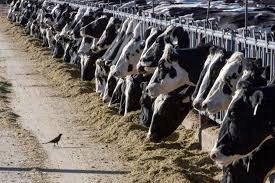 The Friday, March 29th edition of EGG-NEWS reported on the initial diagnoses of bovine influenza-H5N1 infection among dairy cows in Texas, Kansas and New Mexico. During the past week, additional cases were confirmed in Ohio, Idaho and Michigan. The Friday, March 29th edition of EGG-NEWS reported on the initial diagnoses of bovine influenza-H5N1 infection among dairy cows in Texas, Kansas and New Mexico. During the past week, additional cases were confirmed in Ohio, Idaho and Michigan.
The report last week posed eight questions relating to epidemiology of infection among dairy cows and the duration of shedding in milk and recovery of the virus on oropharyngeal swabs and seroconversion in infected animals.
There have been no meaningful reports from APHIS, and it is hoped that the Agency is addressing obvious questions concerning animal-to-animal transmission, susceptibility and the characteristics of the virus. Given the rapid spread of the infection that now involves 12 herds among six states, it is anticipated that additional segments of the dairy industry will be involved.
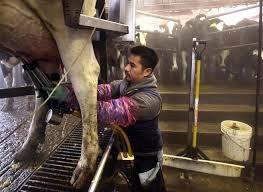 Both the dairy industry and APHIS should be proactive in releasing information in advance of the opponents of intensive livestock production and specifically, the anti-dairy cohort who will be posting misinformation directed at establishing concern among consumers regarding fluid milk and dairy products. Both the dairy industry and APHIS should be proactive in releasing information in advance of the opponents of intensive livestock production and specifically, the anti-dairy cohort who will be posting misinformation directed at establishing concern among consumers regarding fluid milk and dairy products.
There is evident concern over potential transmission by workers and feed delivery vehicles from and among dairy herds and commercial turkey and egg-production flocks in states where bovine influenza-H5N1 has emerged.

|
USDA to Host a Webinar for Livestock Producers, Poultry Growers, on Stockyards Act Final Rule
|
04/04/2024 |
|
 The U.S. Department of Agriculture (USDA) Agricultural Marketing Service (AMS) will host a webinar April 9, 2024, at noon ET, for livestock producers, poultry growers, and regulated entities to share information regarding the Inclusive Competition and Market Integrity under the Packers and Stockyards Act Final Rule. The U.S. Department of Agriculture (USDA) Agricultural Marketing Service (AMS) will host a webinar April 9, 2024, at noon ET, for livestock producers, poultry growers, and regulated entities to share information regarding the Inclusive Competition and Market Integrity under the Packers and Stockyards Act Final Rule.
Registration is required: https://www.zoomgov.com/webinar/register/
WN_dMcIs6UzQTuUq9J6KFqdng
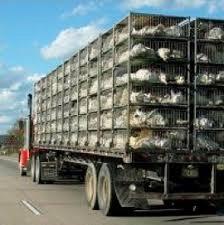
Attendees may submit questions in advance to AMS-AskPSD@usda.gov. Questions will also be accepted during the webinar.
USDA published the final rule in the Federal Register on March 6, 2024, to be effective May 6, 2024.

|
Ziggity Systems Seeks Account Manager
|
04/04/2024 |
|
 Ziggity Systems is seeking an Account Manager with a strong entrepreneurial mindset and enthusiasm for working in the poultry industry. As an Account Manager, you will facilitate distributors’ success by serving as an important technical and marketing resource. Ziggity Systems is seeking an Account Manager with a strong entrepreneurial mindset and enthusiasm for working in the poultry industry. As an Account Manager, you will facilitate distributors’ success by serving as an important technical and marketing resource.
Your responsibilities in this role will include:
- Spreading awareness of important poultry watering concepts and equipment
- management principles
- Public speaking engagements.
- Hands-on farm visits.
- Working with local distributors on large-scale equipment sales and installations.
- Building and maintaining relationships with accounts through continued
- communication

Requirements:
- Bachelor’s Degree
- Excellent interpersonal relationship and negotiation skills
- Travel; up to 75%
- General computer proficiency
The selected candidate for this position will undergo extensive training during orientation.
Benefits:
- A competitive salary with commission structure
- 401(k), health and dental insurance, life insurance, paid vacation
Respond by E-mail with a current CV to Rob Steiner rsteiner@ziggity.com

|
PEAK 2024 Pre-Registration Deadline: Monday, April 8
|
04/04/2024 |
|
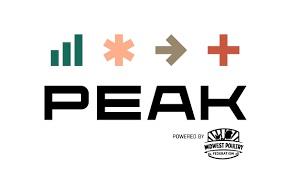 Two weeks to go and PEAK 2024 descends upon Minneapolis! Two weeks to go and PEAK 2024 descends upon Minneapolis!
If you've already made your plans to attend, thank you and we're excited to see you!
If you still need to register, NOW is the time to check that off your list!
Online pre-registration at our special early bird rates will end Monday, April 8.
After that, registrations will shift onsite to the Minneapolis Convention Center
starting Wednesday, April 17 - at a higher rate.

|
NOAA Predicts Low Mississippi River Water Level with Obvious Cost Implications
|
04/03/2024 |
|
 The National Oceanic and Atmospheric Administration (NOAA) predicts a third consecutive year of hot and dry weather in the Mississippi River Basin. For the past two years, low water level has impeded barge shipment along the Mississippi River system. For a few weeks during 2022, 100 towboats and 2,000 barges were idled as a result of low water level. This was followed by a similar period of reduced traffic during late August through September 2023. Less volume transported as a result of limiting passage raises freight rates. This directly places competitors of the U.S. including Brazil and Argentine at an advantage, impacting the volume of U.S. exports. Increased freight rates are reflected in higher feed costs for broiler and egg producers in the Southeast since there is reliance on barge transport for major ingredients. Alternatives including road and rail freight are unable to compensate for delays and restrictions on the Mississippi waterway. The National Oceanic and Atmospheric Administration (NOAA) predicts a third consecutive year of hot and dry weather in the Mississippi River Basin. For the past two years, low water level has impeded barge shipment along the Mississippi River system. For a few weeks during 2022, 100 towboats and 2,000 barges were idled as a result of low water level. This was followed by a similar period of reduced traffic during late August through September 2023. Less volume transported as a result of limiting passage raises freight rates. This directly places competitors of the U.S. including Brazil and Argentine at an advantage, impacting the volume of U.S. exports. Increased freight rates are reflected in higher feed costs for broiler and egg producers in the Southeast since there is reliance on barge transport for major ingredients. Alternatives including road and rail freight are unable to compensate for delays and restrictions on the Mississippi waterway.

Under the bipartisan infrastructure law, funding has been allocated to improved bulk terminal grain storage and handling. Dredging channels and upgrading of locks is in progress after neglect for decades. Notwithstanding improvements, the entire transport system is reliant on an adequate water level that is in turn determined by rainfall and melting of snowpack in the Mississippi catchment area.

|
Cal-Maine Foods Reports on Q3 of FY 2024
|
04/02/2024 |
|
 In a release dated April 2nd Cal-Maine Foods Inc. (CALM) announced results for the 3rd Quarter of FY 2024 ending March 2nd 2023. This report summarizes data provided in the Company release and the concurrently filed SEC 10-Q Report. In a release dated April 2nd Cal-Maine Foods Inc. (CALM) announced results for the 3rd Quarter of FY 2024 ending March 2nd 2023. This report summarizes data provided in the Company release and the concurrently filed SEC 10-Q Report.
It is noted that market conditions during Q3 2023 were exceptional with an average unit revenue for Cal-Maine of $3.30 per dozen for all eggs, compared with Q3 2024 with a corresponding price of $2.25 per dozen.
Cal-Maine represents a bellwether for the shell egg sector as the only public-quoted, pure-play egg company in the industry, supplying 18 percent of domestic shell egg consumption. The following table summarizes the results for the period compared with the values for the corresponding quarter of the previous fiscal year (Values expressed as $ x 1,000 except EPS)
|
3rd Quarter Ending
|
March 2nd
2024
|
March 2nd
2023
|
Difference (%)
|
|
Sales:
|
$703,076
|
$997,493
|
-29.5
|
|
Gross profit:
|
$218,572
|
$463,026
|
-52.8
|
|
Operating income :
|
$162,787
|
$407,783
|
-60.1
|
|
Pre-tax income
Net income
|
$185,159
$146,363
|
$424,887
$322,769
|
-56.4
-54.7
|
|
Diluted earnings per share:
|
$3.00
|
$6.62
|
-54.7
|
|
Gross Margin (%)
|
31.1
|
46.4
|
-32.9
|
|
Operating Margin (%)
|
23.2
|
40.8
|
-43.1
|
|
Profit Margin (%)
|
20.8
|
32.4
|
-35.8
|
|
Non-current liabilities
|
nil
|
nil
|
0
|
|
12 Months Trailing:
|
|
|
|
|
Return on Assets (%)
|
19.0
|
|
|
|
Return on Equity (%)
|
30.6
|
|
|
|
Operating Margin (%)
|
6.5
|
|
|
|
Profit Margin (%)
|
16.9
|
|
|
|
Total Assets March 2nd 2024/June 3rd 2023
|
$2,133,529
|
$1,954,525
|
+9.2
|
|
Market Capitalization April 2nd 2024/June 3rd 2023
|
$2,870,000
|
$2,330,000
|
+15.5
|
Notes: $22.4 million ‘other income,’ Q3 2024 compared to $17.1 million in Q3 FY2023:
$ 0.44 million royalty income, Q3 2024 compared to $0.43 million Q3 FY2023
$ 11.3 million patronage dividends, Q3 2024 compared to $10.2 million Q3 FY2023
$7.5 million interest income, Q3 FY2024 compared to $6.1 million Q3 FY2023
$0.4 million loss on non-controlling interest Q3 2024 compared to $0.5 million Q3 FY202.
$96 million expenditure on properties and equipment in Q3 2024 compared to $86 million in Q3 2023.
Fassio Farms acquisition in Q2 2024: comprised 1.2 million hens, housing, packing plant and feed mill etc.
for $53.7 million representing $44.80/hen
Trailing P/E 6.4
52-Week Range in Share Price: $42.25 to $62.58 50-day Moving average $57.56
Market Close, Wednesday, April 2nd $58.91 pre-release.
Post release, after-hours, 17H40 up 6.0 percent to $62.42.
In reviewing the CALM Q2 2024 quarterly report and the SEC 10-Q submission the following calculated values represent key data for the most recent Quarter of FY 2024. (Q3 for FY 2023 and percentage differences in parentheses):-
- Shell egg sales attained $675,850 million in Q3 2024 based on shell eggs comprising 96.2 percent of total revenue. ($961,090 million, in Q3 2023, based on 96.4 percent of revenue). (Sales value for shell eggs was down 29.7% reflecting lower average unit value).
- Dozen shell eggs sold (thousands): 300,779 (291,416; +3.2%)
- Average selling price of all shell eggs: $2.25 per dozen; ($3.30 per dozen; -31.9%).
- Average selling price of specialty eggs (excluding co-pack): $2.42 cents per dozen; ($2.62 per dozen; -7.7%).
- Average selling price of generic eggs: $2.15 cents per dozen; ($3.68 cents per dozen; -41.5%).
- Differential between specialty eggs and generic eggs: +$0.26 cents per dozen; (-$1.06 per dozen)
- Specialty eggs as a proportion of volume sold: 36.1%; (35.7%; +1.1%)
- Specialty eggs as a proportion of sales value: 38.5%; (28.2%; +36.5%)
- Proportion of eggs sold that were produced by Cal-Maine and their contract flocks in Q3 FY2024 : 86.3% (90.3%; -4.4%).
- Farm feed cost: 54.4 cents per dozen, (67.9 cents per dozen, -19.9%) Includes specialty and breeder diets. Differential represents $42.2 million over Q3.
- Egg product sales in Q3 FY 2024 attained $21.8 million or 3.1% of sales value at a unit price of $1.16 per lb. For Q3 2023, sales of $32.6 million were down 33.1% in value with a unit price of $1.94 per lb. down 40.2% in unit value.
- Cal-Maine Foods maintained a flock of 41.2 million hens on average during FY 2023 with 10.8 million pullets plus parent breeders representing less than two percent of the total flock.
The following observations relate to the comparison of Q3 2024 with the corresponding Q3 FY2023:-
- Cal-Maine Foods was not affected by the 2022-2023 HPAI epornitic during FY 2022 or FY 2023. During Late December 2023 (Q3 FY 2024) the Chase, KS. Complex comprising 1.5 million hens and 240,000 pullets, representing 3.3% of the total flock was depopulated as a result of HPAI. On April 1st 2024 (Q4 2024) the Farwell, TX complex was confirmed positive requiring depopulation of 1.6 million hens and 0.34 million pullets.
- Q3 of FY 2024 represented a less favorable marketing comparison to Q3 FY 2023 based on lower prices for shell eggs, as U.S. flocks were re-populated, coupled with restoration of normal consumer demand. Average shell egg price obtained by Cal-Maine was 31.9 percent lower than in Q 3 FY 2023.
- Comparing Q2 FY 2024 with Q2 FY 2023 gross profit was impacted negatively by lower unit revenue for generic eggs although with some benefit from specialty eggs. The 19.9 percent lower feed cost to 54.4 cents per dozen was partly offset by 5.5 percent higher farm production costs attaining 42.1 cents per dozen,
- In a market characterized by low unit prices for generics, the relative contribution of specialty eggs is more important to net earnings in contrast to an up-market for conventional eggs. Normality was restored in FY 2024 with generic eggs at a lower unit price and margin compared to specialty eggs.
In commenting on Q3 results Sherman Miller, president and CEO stated, , “We are very pleased with Cal-Maine Foods’ strong financial and operating performance for the third quarter of fiscal 2024. Our sales reflect lower average selling prices compared to a year ago, when the shell egg industry experienced record high market prices due primarily to the impact of highly pathogenic avian influenza (“HPAI”) and other market factors resulting in a significant reduction in supply. While the more recent outbreaks of HPAI have also affected supply and caused market prices to move higher, the overall market impact has not been as severe. Fueled by strong demand, our total sales volumes (dozens sold) for the quarter were higher than the third quarter of fiscal 2023 and reached a Company record. Consumer demand for eggs has been strong, especially during the winter holiday season. We have worked hard to meet this demand with a favorable product mix of conventional and specialty eggs, as well as enhanced egg products offerings. Our managers and employees have continued to efficiently run our operations in a challenging environment due to the impact of and ongoing threat of HPAI. Despite the distractions, we have continued to meet the needs of our valued customers”.

Referring to acquisitions Miller stated “In addition to our strong organic growth opportunities, we are pleased with the operational performance and successful integration of our acquisition of assets of Fassio Egg Farms, Inc., located in Erda, Utah outside of Salt Lake City, acquired in our second fiscal quarter. Following the end of the third quarter, we completed the acquisition from Tyson Foods, Inc. (NYSE:TSN) of a recently closed broiler processing plant, hatchery and feed mill located in Dexter, Missouri. We intend to repurpose the acquired assets for use in egg and egg products production. We remain focused on identifying other acquisition opportunities that complement our operating model and further extend our market reach.”
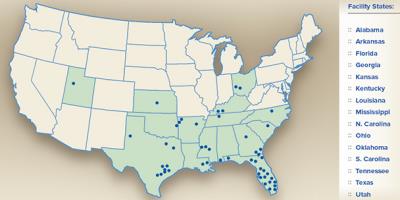
The 10-Q Report documented approved capital investment of $233 million for cage-free conversions and additional upgrades to processing for FY 2024 through FY 2027 with a provision for improvements to the Missouri broiler complex acquired from Tyson Foods. Of this total $152 million has been committed with $81 million to be expended.
During late 2022 Cal-Maine Foods joined in the formation of ProEgg, Inc. a Capper-Volstead Act Farmers’ Cooperative to distribute eggs in 13 western states. The objective is to enhance service to customers in the region by ensuring a secure supply chain.

|
Dow and P&G Collaborate in Recycling Technology
|
04/02/2024 |
|
 Dow Chemical and Proctor & Gamble are evaluating a dissolution process to recycle polyethylene packaging. This technology involves dissolving plastic packaging in a solvent, followed by separation and remanufacturing. As distinct from advanced recycling, the polyethylene will not be degraded to produce a virgin product. According to experts the physical process has the potential to reuse material to reduce the quantity of plastic waste. Dow Chemical and Proctor & Gamble are evaluating a dissolution process to recycle polyethylene packaging. This technology involves dissolving plastic packaging in a solvent, followed by separation and remanufacturing. As distinct from advanced recycling, the polyethylene will not be degraded to produce a virgin product. According to experts the physical process has the potential to reuse material to reduce the quantity of plastic waste.
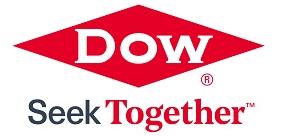
Proctor & Gamble has undertaken to recycle or reuse all plastic packaging by 2030.

|
Wesley and Joesley Batista to Rejoin JBS S.A. Board
|
04/02/2024 |
|
 JBS SA the operating company under J&F Investimentos has announced that brothers Wesley and Joesley Batista will rejoin the board of directors. The question arises as to whether they de facto ever left the board. They resigned their positions in 2017 following a series of scandals relating to wide scale bribery of politicians in Brazil. In addition, it was alleged that the brothers sold shares in the company based on an agreement with the Ministry of Justice that was not common knowledge thereby averting losses when the agreement was announced. JBS SA the operating company under J&F Investimentos has announced that brothers Wesley and Joesley Batista will rejoin the board of directors. The question arises as to whether they de facto ever left the board. They resigned their positions in 2017 following a series of scandals relating to wide scale bribery of politicians in Brazil. In addition, it was alleged that the brothers sold shares in the company based on an agreement with the Ministry of Justice that was not common knowledge thereby averting losses when the agreement was announced.
 Subsequently the Batista brothers returned to management roles at J&F in 2020 and were exonerated in 2023 by the Brazilian Securities and Exchange Commission. Both brothers are now directors of Pilgrim’s Pride and their presence on the board of JBS SA will be a consideration as to whether the company will be listed on the NYSE. Subsequently the Batista brothers returned to management roles at J&F in 2020 and were exonerated in 2023 by the Brazilian Securities and Exchange Commission. Both brothers are now directors of Pilgrim’s Pride and their presence on the board of JBS SA will be a consideration as to whether the company will be listed on the NYSE.

|
Outbreak of HPAI in the Philippines
|
04/02/2024 |
|
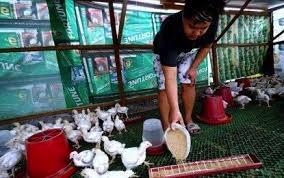 ProMED reported on an outbreak of avian influenza on a farm in the Municipality of Kananga located in central Leyte Province. Approximately 60,000 breeder chickens (type not specified) were depopulated. The outbreak was reported by the Department of Agriculture for the Eastern Visayas region on March 25th. The source has not been determined but migratory birds are suspected of introducing infection. ProMED reported on an outbreak of avian influenza on a farm in the Municipality of Kananga located in central Leyte Province. Approximately 60,000 breeder chickens (type not specified) were depopulated. The outbreak was reported by the Department of Agriculture for the Eastern Visayas region on March 25th. The source has not been determined but migratory birds are suspected of introducing infection.
Authorities in the Province of Cebu have announced a ban on entry of live birds from Leyte as a precaution.

The Philippines has notified the WOAH of more than 280 outbreaks of H5N1 avian influenza since the beginning of 2022 and the infection should be regarded as endemic. Since the Philippines is a net importer of poultry meat and eradication is not possible, vaccination would appear to be an appropriate strategy. This approach has been initiated to control ASF that is also endemic and has not responded to traditional methods of control.

|
Reich Accuses Walmart of Price Gouging
|
04/02/2024 |
|
In a March 23rd tweet Robert Reich, Professor of Economics at UCLA, Berkeley, and formerly Secretary for Labor in the Clinton Administration, accused Walmart of excessive pricing contributing to inflation. This follows an announcement of increases in shelf prices for their Great Value private brand.
The comments by Reich, follow accusations from the White House concerning food inflation, citing price increases (‘gouging’) per unit of product and reducing the size of packs (‘shrinkflation’). The White House blame game was echoed by the Federal Trade Commission in a report implicating all the major chains including Walmart, Amazon, Kroger and Target in maintaining high prices, notwithstanding easing of supply chains.
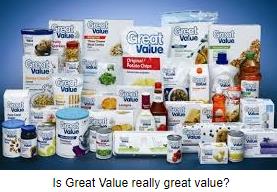
Simply citing the gross margins and net profits of companies including Walmart and Target that sell a diverse range of products does not specifically show a policy of excessive pricing of groceries.

|
H5N2 HPAI Diagnosed in Mexico
|
04/02/2024 |

|
Dairy Farm Worker Diagnosed with H5N1 Avian Influenza Virus
|
04/02/2024 |
|
Press reports and a ProMED posting on April 1st confirmed isolation of H5N1 virus, presumably by applying PCR from a farm worker in contact with a dairy herd infected with the virus.
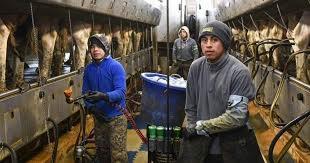
At the outset, it is emphasized that the condition now diagnosed in dairy herds in New Mexico, Texas, Idaho, Michigan and Kansas should be termed “Bovine Influenza- H5N1”.
According to reports, the affected individual showed conjunctivitis suggesting infection by virus entrained on dust consistent with the environment of herds held in barns. Previously avian influenza H5N1 virus was demonstrated in a single case in the U.S., apparently three individuals in Spain in 2022 working with infected mink and two cases of individuals exposed to dead migratory birds in South America last year.
The previous case of H5N1 infection in the U.S. occurred in a worker involved in depopulation of an infected flock in Colorado. The patient was asymptomatic and there was no evidence of human-to-human transmission to contacts. It must be remembered that during the 2015 followed by the 2022-2023 epornitics, thousands of worker-hours were spent in depopulating farms with only one asymptomatic case, despite surveillance. This report may have been simply isolation of inhaled viral RNA from nasal passages obtained on routine sampling of workers. Some cases of H5N1 have demonstrated mild upper respiratory symptoms as in the case of an elderly man in the U.K. that harbored live infected ducks in his home.
A news item posted in the March 29th edition of EGG-NEWS discussed the outbreak of bovine influenza-H5N1. Until information is provided concerning the molecular biology of the isolates from herds in diverse states including any possible mutations, it will be difficult to relate the apparent susceptibility of ruminants to an avian virus or to establish zoonotic risk.
According to claims, milk from affected cows is destroyed and has not entered the fluid milk channel. In any event, pasteurization will destroy any influenza virus passed into milk produced by affected cows. It is not clear whether all milk from an infected herd is withheld from market or only product from a clinically affected animal showing reduced milk volume and organoleptic changes. There is an obvious question as to whether infected but clinically unaffected viremic cows in the herd are passing virus to milk. To date, there has been no data on either morbidity or prevalence of viremia within an affected herd, although it can be assumed that direct animal-to-animal transmission has occurred.
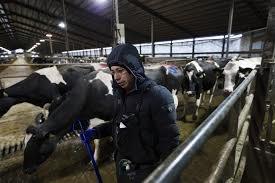
Hopefully, APHIS is gathering data and conducting studies to identify the source and routes of introduction of infection into herds. Preliminary evidence suggests that movement of cattle has resulted in inter-herd infection.
The Centers for Disease Control and Prevention is cooperating with state and federal agencies to monitor and investigate possible human exposure.
The somewhat alarming incidence rate of bovine influenza H5N1 corresponded to the apparent cessation of outbreaks in commercial poultry in preceding weeks, although APHIS has diagnosed cases in backyard flocks and yesterday in one egg-production complex in Farwell, TX. on the border with New Mexico. A second occurred in a western Michigan farm holding 1.9 million hens. The non-commercial cases have occurred in numerous states since the onset of the infection in dairy herds, approximately one month ago.
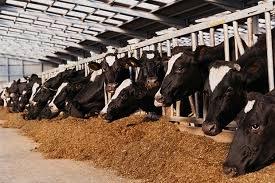
The moderator of the ProMED posting on March 29th, requested details of personal protective equipment worn on farms and by workers at slaughter plants to which culled dairy animals have been consigned. The moderator also commented on the need for serologic surveys in addition to viral isolation and characterization.
Poultry health professionals, farmers and consumer groups await regular and informed releases by USDA and CDC concerning the livestock and human components of bovine influenza- H5N1.

|
Loblaw Engenders Negative Response to Self-Checkout Verification
|
04/02/2024 |
|
 Faced with losses associated with self-scanning the Loblaw chain in Canada introduced a pilot program in Ontario to verify the accuracy of self-checkout. The process required consumers to scan receipts before releasing a barrier to exit the lane. Consumer response was decidedly negative since the system implied that all customers were larcenous-a sentiment that should have occurred to whoever approved the project. Faced with losses associated with self-scanning the Loblaw chain in Canada introduced a pilot program in Ontario to verify the accuracy of self-checkout. The process required consumers to scan receipts before releasing a barrier to exit the lane. Consumer response was decidedly negative since the system implied that all customers were larcenous-a sentiment that should have occurred to whoever approved the project.

A public advocacy group, Leadnow addressed a letter to the CEO of Loblaw noting that the verification of receipts could represent a slippery slope for added surveillance and harassment. A site Loblaw is Out of Control was established on Reddit, suggesting a boycott of the chain and affiliates. The group has 25,000 members and its influence is certainly detrimental to the Loblaw image.
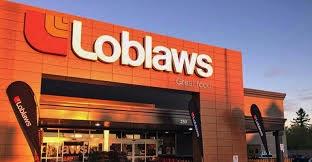
The negative response to the Loblaw initiative should be instructive to supermarket chains using self-checkout based on disfavor from customers. Chains including the U.S. Dollar Stores are removing self-checkout or restricting the number of items purchased based on the soaring rates of shrinkage.
To quote Fagin a character in Oliver, Loblaw will have to “Think I’ll have to think it out again.”

|
U.K. Egg Producers Subject to Farm Intrusions
|
04/01/2024 |
|
Organizations in the U.K. including the Animal Justice Project continue to break into farms and release videos purporting to show inappropriate housing and management. A recent episode received extensive press attention as the farm selected is owned and operated by a director of the British Free Range Egg Producers Association.
 Not only are images cherry-picked to demonstrate a specific problem, but inappropriate and misleading captions are also supplied to media. In the specific case, a flock, shortly before depopulation, was shown with a number of hens demonstrating normal feather loss. The second image showed that outside access was limited by closed ‘popholes’. This flock was apparently undergoing vaccination. Not only are images cherry-picked to demonstrate a specific problem, but inappropriate and misleading captions are also supplied to media. In the specific case, a flock, shortly before depopulation, was shown with a number of hens demonstrating normal feather loss. The second image showed that outside access was limited by closed ‘popholes’. This flock was apparently undergoing vaccination.
Despite the fact that U.K. egg producers were coerced into transitioning to free-range production, current action by animal rights groups demonstrates that it is impossible to satisfy pro-vegan zealots. Their objective is to displace all forms of intensive livestock production in favor of their chosen lifestyle that they appear intent on imposing on all consumers.
|
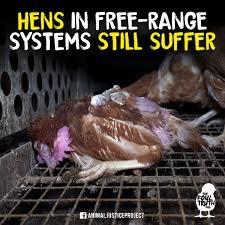
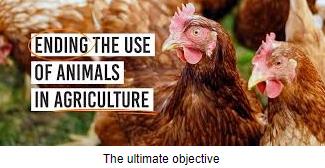 |

|
Ocean Transport of Live Animals
|
03/31/2024 |
|
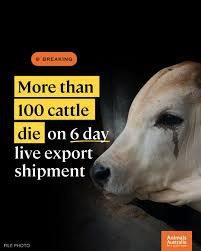 Previously EGG-NEWS and CHICK-NEWS have commented unfavorably on the transport of cattle and sheep from Australia and New Zealand to Indonesia and other nations in the Middle East for ritual halal slaughter. Recently a consignment of cattle from Australia to Indonesia was impacted by botulism resulting in the death of at least 100 head of cattle. The circumstances relating to the toxicity are under review by the Department of Agriculture and the Australian Previously EGG-NEWS and CHICK-NEWS have commented unfavorably on the transport of cattle and sheep from Australia and New Zealand to Indonesia and other nations in the Middle East for ritual halal slaughter. Recently a consignment of cattle from Australia to Indonesia was impacted by botulism resulting in the death of at least 100 head of cattle. The circumstances relating to the toxicity are under review by the Department of Agriculture and the Australian 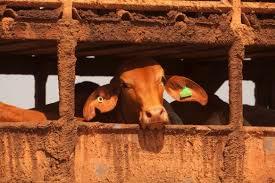 Livestock Exporters’ Council. This incident will intensify opposition to shipment of live animals that are intended for slaughter as reflected in proposed legislation. Cattle and sheep could be processed according to halal rites and exported as processed carcasses under refrigeration. Livestock Exporters’ Council. This incident will intensify opposition to shipment of live animals that are intended for slaughter as reflected in proposed legislation. Cattle and sheep could be processed according to halal rites and exported as processed carcasses under refrigeration.

|
Kroger and Albertsons Face Uphill Battle Over Proposed Merger
|
03/31/2024 |
|
 Both the Kroger Company and Albertsons Corporation have filed rebuttals to the Federal Trade Commission move to block the proposed merger. Both the Kroger Company and Albertsons Corporation have filed rebuttals to the Federal Trade Commission move to block the proposed merger.
Albertsons maintains that the FTC is “willfully ignorant of basic and critical facts” and the Commission ignores the “realities of the competitive grocery landscape”. In the Albertsons submission, the company cited extreme competition from Walmart, Target, Costco and Amazon.
 The rebuttals also claim that C&S will be capable of successfully managing the stores to be divested. The companies note that labor in their stores is both non-union and union affiliated and that the merger would not dilute the power of unions. The rebuttals also claim that C&S will be capable of successfully managing the stores to be divested. The companies note that labor in their stores is both non-union and union affiliated and that the merger would not dilute the power of unions.
It is a matter of fact that the FTC embarked on an extensive nine-month evaluation of the grocery market interviewing suppliers, consumer groups and unions in addition to inviting submissions from both Kroger and Albertsons. To claim that the FTC based its decision on distortion and ignorance would appear to be an inappropriate and unproductive approach in advance of the review by an FTC administrative law judge.
Judge Andrew Luxen of the Denver District Court has announced that the preliminary injunction preventing the merger between Albertsons Corporation and the Kroger Company would be heard on August 12th and the proceedings will run through the 22nd. The State of Colorado filed the lawsuit on February 14th and is joined by the Attorneys General of eight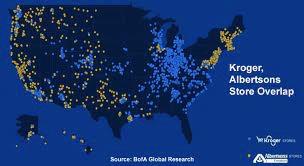 states and Washington, D.C. states and Washington, D.C.
The Kroger-Albertsons merger agreement was due to have been concluded on October 9th. The reality of prolonged litigation will necessitate an extension since a cancellation appears unlikely.

|
2024 White House Colonnade of Eggs
|
03/31/2024 |
|
 A press release from the American Egg Board highlighted the annual Colonnade of Eggs as a part of Easter traditions celebrated at the White House. Egg producers collaborated with the White House to celebrate and support those who serve our Country and their families. Located in the East Colonnade of the White House, the exhibit features eggs designed by children from National Guard families across the country. Children from all fifty states, the District of Columbia, Guam, Puerto Rico and the U.S. Virgin Islands participated in the event. Featured contributors included deigns by Allyson (Ally) P., Colorado, age 8, Michaela W., Michigan, age 16 and Leeam M., Puerto Rico, age 9 A press release from the American Egg Board highlighted the annual Colonnade of Eggs as a part of Easter traditions celebrated at the White House. Egg producers collaborated with the White House to celebrate and support those who serve our Country and their families. Located in the East Colonnade of the White House, the exhibit features eggs designed by children from National Guard families across the country. Children from all fifty states, the District of Columbia, Guam, Puerto Rico and the U.S. Virgin Islands participated in the event. Featured contributors included deigns by Allyson (Ally) P., Colorado, age 8, Michaela W., Michigan, age 16 and Leeam M., Puerto Rico, age 9
“On behalf of the American Egg Board and America’s egg farmers, we are proud to support those who serve our country and their families through this special exhibit and of course to highlight eggs and egg farmers,” said Emily Metz, president and CEO of the American Egg Board. “Each handcrafted egg highlights the unique experiences and stories of these children for thousands of tourists to see during the Easter season at the White House.”

For the past 47 years, the American Egg Board, on behalf of its egg farmers, has presented a Commemorative Egg to the First Lady that reflects individual causes and contributions in service to the nation. Commemorative Eggs are produced by talented artists from across the country. For the last three years, the American Egg Board has collaborated with the White House on exhibits that showcase egg art during the spring season.

|
BJ's Wholesale Club Posts Q4 and FY 2023 Results
|
03/30/2024 |
|
On March 7, BJ's Wholesale Club Holdings Inc. (BJ) announced results for Q4 and FY 2023 ending February 3rd 2024. The Company posted topline and EPS consistent with consensus estimates resulting in a sharp increase in share price following the Q4 release.

For the period, the company earned $145.9 million on revenue of $5,357 million with a diluted EPS of $1.10. Comparable figures for Q4 FY 2022 were net earnings of $129.8 million on revenue of $4,930 million with a diluted EPS of $0.95. For the most recent quarter, BJ’s achieved a gross margin of 16.2 percent (16.6 percent Q4, FY 2022) and an operating margin of 4.0 percent (3.9 percent Q4 FY 2022).
For FY 2023, the company earned $523.7 million on revenue of $19,969 million with a diluted EPS of $3.88. Comparable figures for FY 2022 were net earnings of $513.2 million on revenue of $19,315 million with a diluted EPS of $3.76.
During the quarter, comparable club store sales (excluding fuel) increased by 0.5 percent compared to Q4 FY 2022. Digital sales increased by 28.0 percent.
In commenting on the quarter Bob Eddy, President and Chief Executive Officer stated “We ended fiscal 2023 on a strong note. Our membership grew in robust fashion and we continue to retain members at all-time high rates. We delivered impressive market share gains in our clubs and at our gas pumps, driven by acceleration in traffic and growth in units sold. We improved our merchandising and value proposition meaningfully during the year and increasingly delivered both with greater convenience through our digital offerings. We also continued to grow our chain with six new clubs since the third quarter. I’m proud of our team and our progress and look forward to more growth in the future.”

Guidance for FY 2024 included a 1 to 2 percent increase in comparable store sales; a 20 basis point improvement in gross margin with an adjusted EPS of $3.75 to $4.00.
The Company operates 244 warehouse stores with 175 fuel stations in 20 states. BJs intends to open 12 stores in FY 2024 with five announced openings in TN; SC; FL and IN.
On February 3rd 2023 BJ’s posted total assets of $6,678 million including $1,116 million in goodwill and intangibles, offset by long-term debt and lease obligations of $2,675 million. BJ's had a market capitalization of $10,060 million 0n March 28th. The company has traded over the past fifty-two weeks in a range of $60.33 to $78.97 with a 50-day moving average of $70.48. Following release of the Q4 results, BJ opened at $78.79 up 9.0 percent. Over the trailing twelve-month period, operating margin was 4.3 percent and profit margin 2.6 percent. Return on assets was 7.8 percent and return on equity, 41.8 percent.
BJ’s is a bellwether for the retail sector along with larger competitor big box warehouse clubs Costco and Sam’s. The current retail environment was characterized in the earnings call by comments that consumers are “trading down” and “more discerning.” These sentiments were expressed in recent Target and Walmart investor calls.

|
Kroger Closing Delivery Warehouses
|
03/30/2024 |
|
Kroger has announced that it will close the Opa-locka FL, Austin and San Antonio TX. Delivery Warehouses each approximately 70,000 square foot in extent. These facilities were intended to allow the company to extend the reach of Ocado automated fulfillment centers. The Florida location was linked to the Groveland fulfillment center and the two Texas units interacted with the Dallas, TX. fulfillment center opened in 2022.

It was the intent of Kroger to serve consumers in south Florida without a brick-and-mortar presence by direct delivery using the spoke arrangement.
Kroger has achieved a significant increase in digital sales mostly with pick-up but also delivery amounting to $12 billion in FY 2023. CEO of Kroger, Rodney McMullen pointed to the lowered cost with increased volume and the application of technology to expedite delivery that increased by 24 percent over the year.

Cited in Supermarket News, a spokesperson stated, “Our commitment to innovation means that we test and learn quickly to identify the most effective ways to deliver fresh, affordable food to our customers. Despite our best efforts including the support from customers and the incredible work of our associates these facilities did not meet the benchmarks we set for success.”

|
Impact of Baltimore Bridge Destruction
|
03/30/2024 |
|
 Destruction of the Francis Scott Key Bridge will have profound effects on East-coast shipping and specifically the Port of Baltimore. Until the remnants of the bridge can be removed from the channel, marine traffic has ceased. The Port of Baltimore handled 1.1 million 20-foot equivalent container units in 2023 representing 52.3 million tons of cargo valued at $81 billion. The port supports 15,000 direct jobs and as many as 125,000 connected to the harbor. Loss of the port is estimated to cost the U.S. economy $15 million per day. Shippers are diverting vessels to alternative ports in New York, New Jersey and Virginia. The Port of Baltimore was responsible for four percent of total U.S. agricultural imports in 2023 representing 1.8 million metric tons. Destruction of the Francis Scott Key Bridge will have profound effects on East-coast shipping and specifically the Port of Baltimore. Until the remnants of the bridge can be removed from the channel, marine traffic has ceased. The Port of Baltimore handled 1.1 million 20-foot equivalent container units in 2023 representing 52.3 million tons of cargo valued at $81 billion. The port supports 15,000 direct jobs and as many as 125,000 connected to the harbor. Loss of the port is estimated to cost the U.S. economy $15 million per day. Shippers are diverting vessels to alternative ports in New York, New Jersey and Virginia. The Port of Baltimore was responsible for four percent of total U.S. agricultural imports in 2023 representing 1.8 million metric tons.
The port is ranked 11th in the nation in terms of foreign cargo and the 9th largest in dollar value. Major exports include liquefied natural gas and coal. The port is a major point of entry for manufactured vehicles and automobile components. Although the port only handled 3 million pounds of boneless beef in 2023 compared to Philadelphia at 820 million pounds, Baltimore is a major import point for seafood with 35 million pounds of salmon filets, 25 million pounds of tilapia filets and 20 million pounds of frozen shrimp.
According t o the USAPEEC chicken exports through Baltimore attained 31,500 metric tons valued at $40 million. Production to be exported will be consigned through New Jersey and Virginia ports o the USAPEEC chicken exports through Baltimore attained 31,500 metric tons valued at $40 million. Production to be exported will be consigned through New Jersey and Virginia ports
Based on the magnitude of the calamity and the duration of closure of the port, shippers have declared force majeure. This will allow vessels to dock and unload at alternative ports with the inland freight cost borne by customers.
EGG-NEWS extends condolences to the families of those who lost their lives and commends the courage and determination of first responders and the US Navy and Coast Guard personnel who will be involved in the initial clearing and salvage operations.

|
Consequences of California FAST Wage Law
|
03/30/2024 |
|
 The California law mandating a statewide minimum wage of $20 per hour for restaurant workers is generating predicted consequences. It is estimated that there were 720,000 fast food and limited-service restaurant workers in California at the end of 2023. This figure is down by 1.3 percent from September. In contrast, total employment in the state declined by 0.2 percent. The California law mandating a statewide minimum wage of $20 per hour for restaurant workers is generating predicted consequences. It is estimated that there were 720,000 fast food and limited-service restaurant workers in California at the end of 2023. This figure is down by 1.3 percent from September. In contrast, total employment in the state declined by 0.2 percent.

 Given that the economy still recovering from the effects of COVID and inflation operators are reluctant or unable to pass on increased wages to consumers. Accordingly, restaurants are reducing head count and hours. Pizza Hut franchisees have eliminated most of their drivers, most of whom will be employed by independent delivery services. Some stores have revised menus to reduce labor and are evaluating installation of mechanical handling equipment. Given that the economy still recovering from the effects of COVID and inflation operators are reluctant or unable to pass on increased wages to consumers. Accordingly, restaurants are reducing head count and hours. Pizza Hut franchisees have eliminated most of their drivers, most of whom will be employed by independent delivery services. Some stores have revised menus to reduce labor and are evaluating installation of mechanical handling equipment.

|
Peak 2024
|
03/29/2024 |
|

|
|
|
|
View More
|
Top
|
|